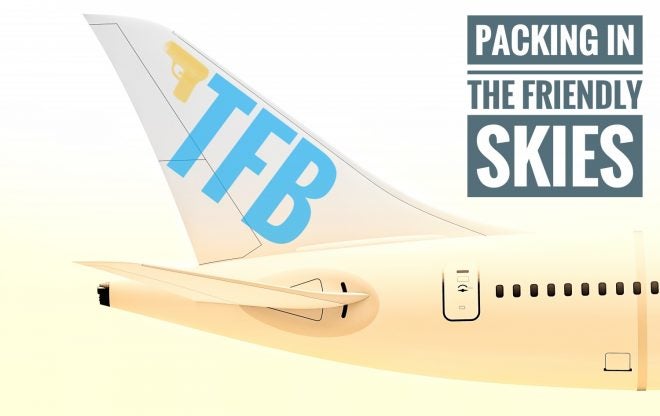The first installment in this series of three articles concerning flying with firearms gave a rundown of what treatment you can anticipate at most airports when you’re checking a gun case as luggage. We discussed how things tend to go smoothly and how you can usually expect your firearms to greet you at your destination with little difficulty.
Most of the time, that is.
This article is about undesired results: times when we’ve encountered problems, had items damaged, or had our locked cases broken into by the TSA or other unknown parties. Learn from our mishaps so that you can guard yourself as best as possible against things going wrong when you’re flying with firearms!
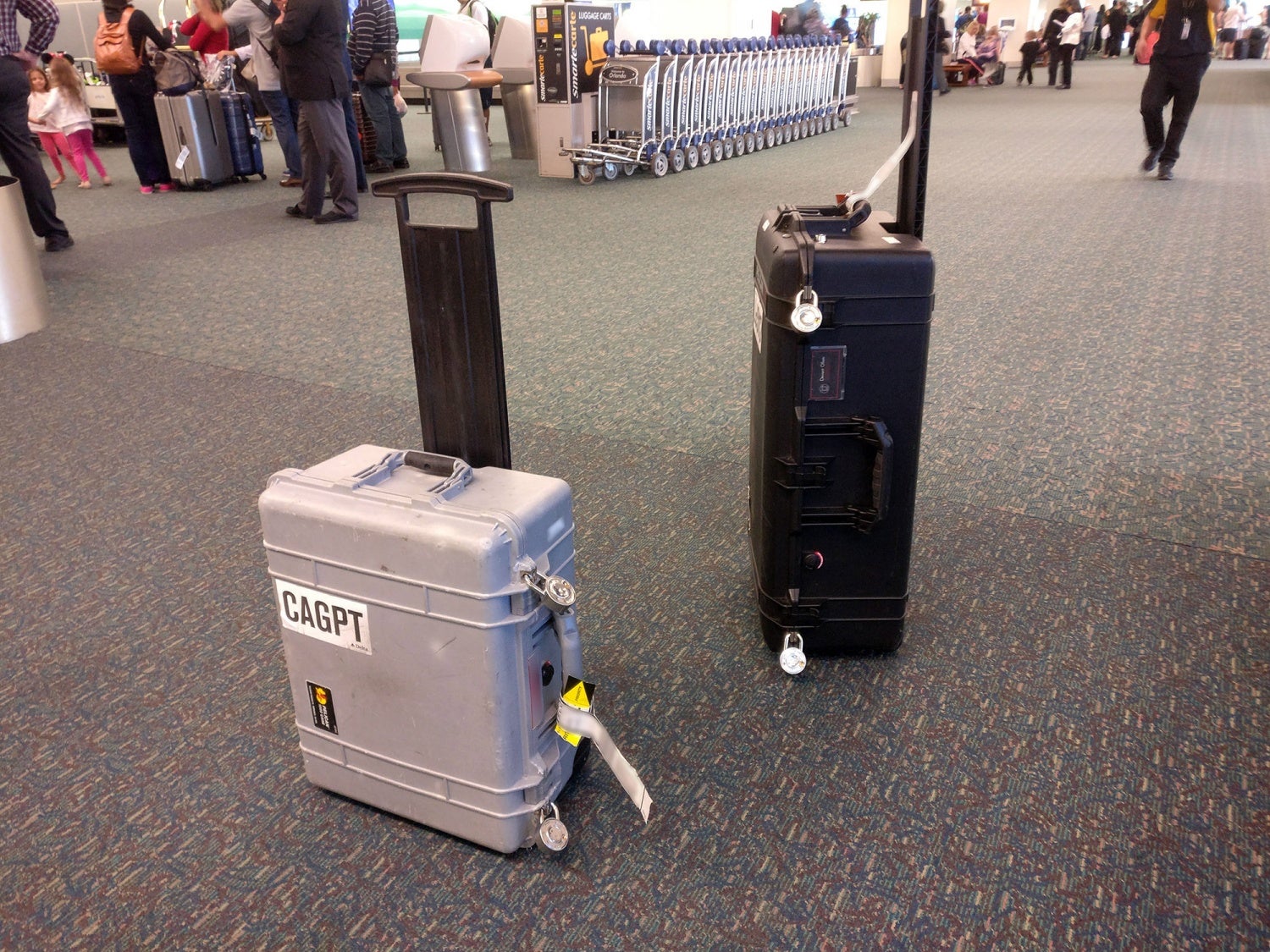
These are two of the author’s gun cases, but those are not the author’s padlocks. On a journey from Las Vegas to Orlando, the TSA broke into the luggage. The exact same thing happened on the return journey from MCO to SEA. Fortunately, the author was able to shim these locks off, as no TSA representatives could provide the combination.
After over a decade of flying with firearms now, my colleagues and I have encountered problem situations from time to time. I have had locks cut off my gun cases by the TSA and then replaced with crappy locks. I have even had locks cut off and replaced merely with zip ties. If this sounds puzzling, recall that a firearm supposedly shall not be permitted to fly in checked luggage if it is “unlocked” and therefore, if airport workers break into a gun case (something that is wildly at odds with policy and best practices, as we will discuss below) they then have to “lock” the case in order to send it along on its journey. Only someone with the brain of a bureaucrat would be able to call zip-tied luggage a “locked case.”
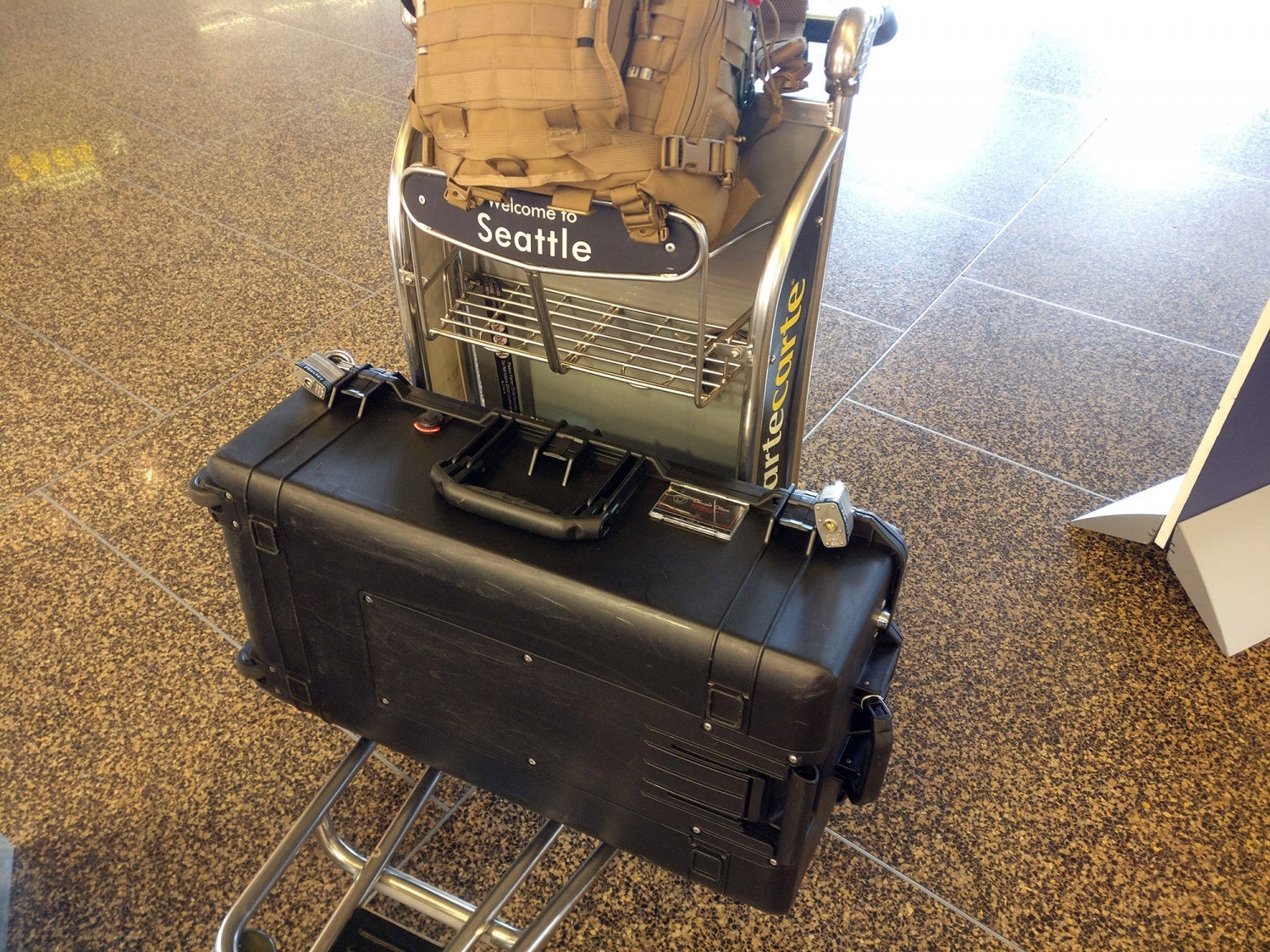
The author’s gun case after small Abloy padlocks had been cut off by the TSA and replaced with conventional hardware store Master Locks.
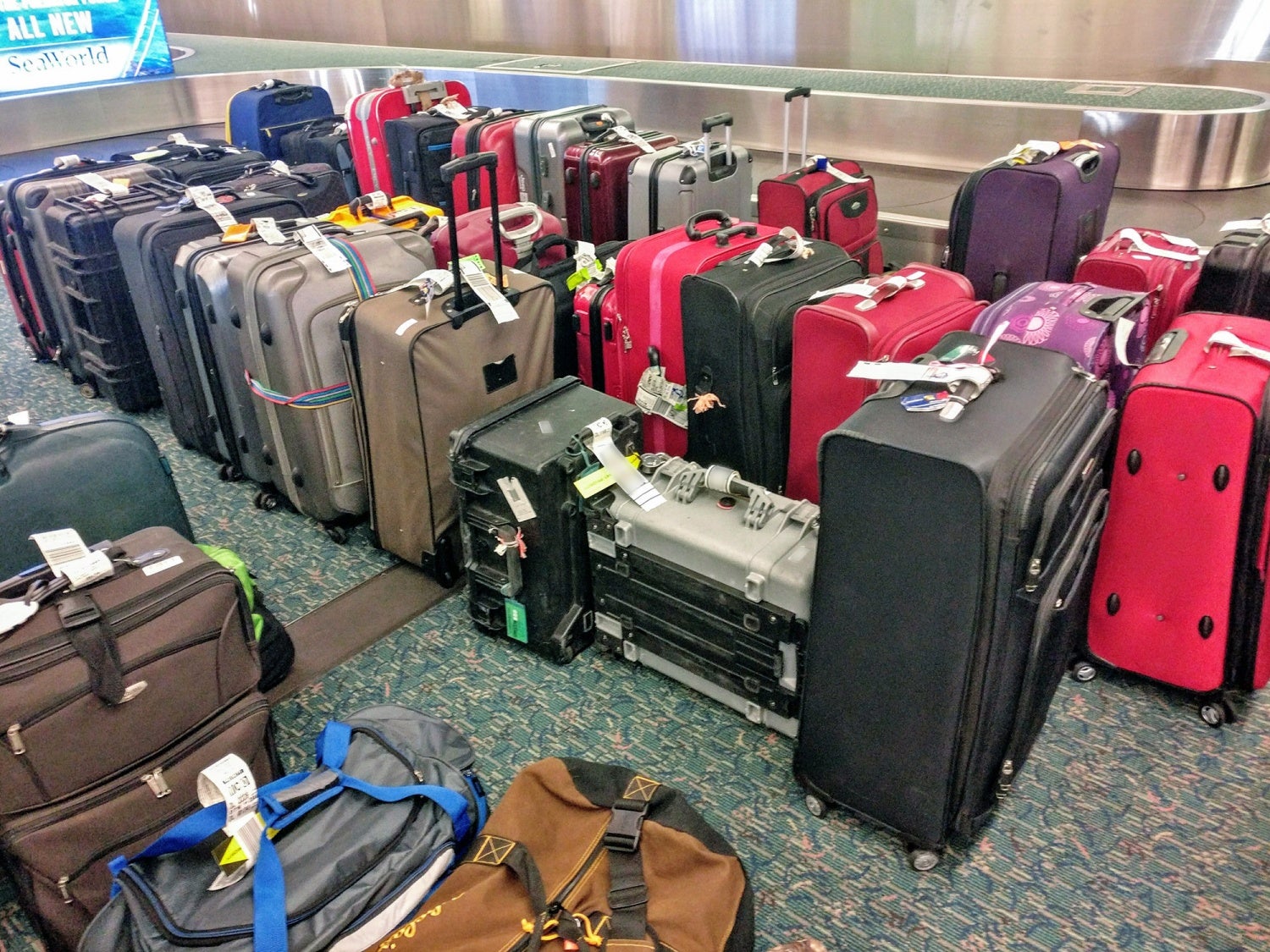
Pelican cases with firearms lay strewn amid other articles of misrouted luggage during a particularly disastrous week of system-wide travel delays and disruptions. The original locks have been cut off and, in one instance, replaced with crappy combination-style gym locker padlocks.
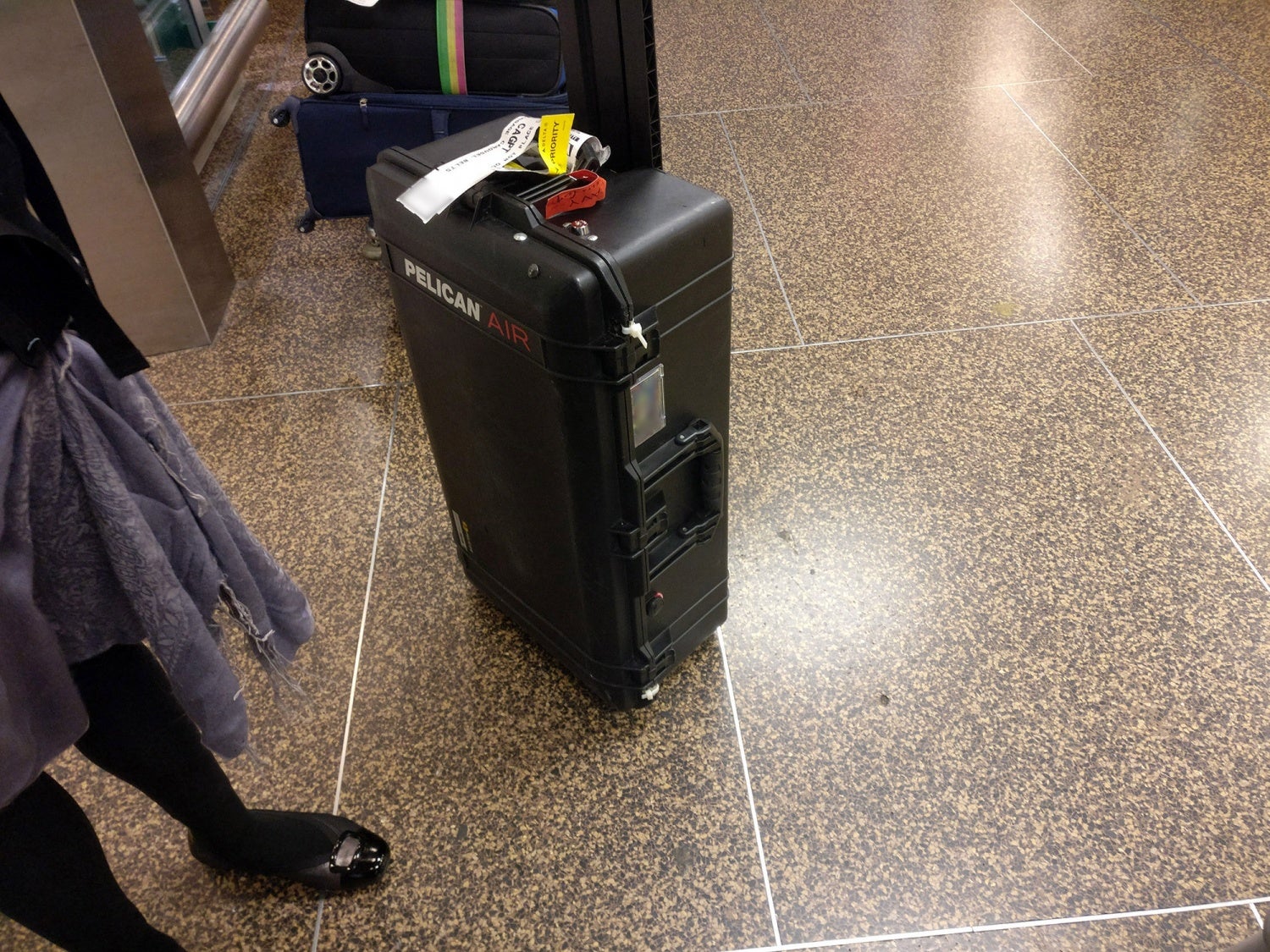
Author’s wife’s firearm-bearing Pelican case which has had its locks cut off and replaced with zip ties.
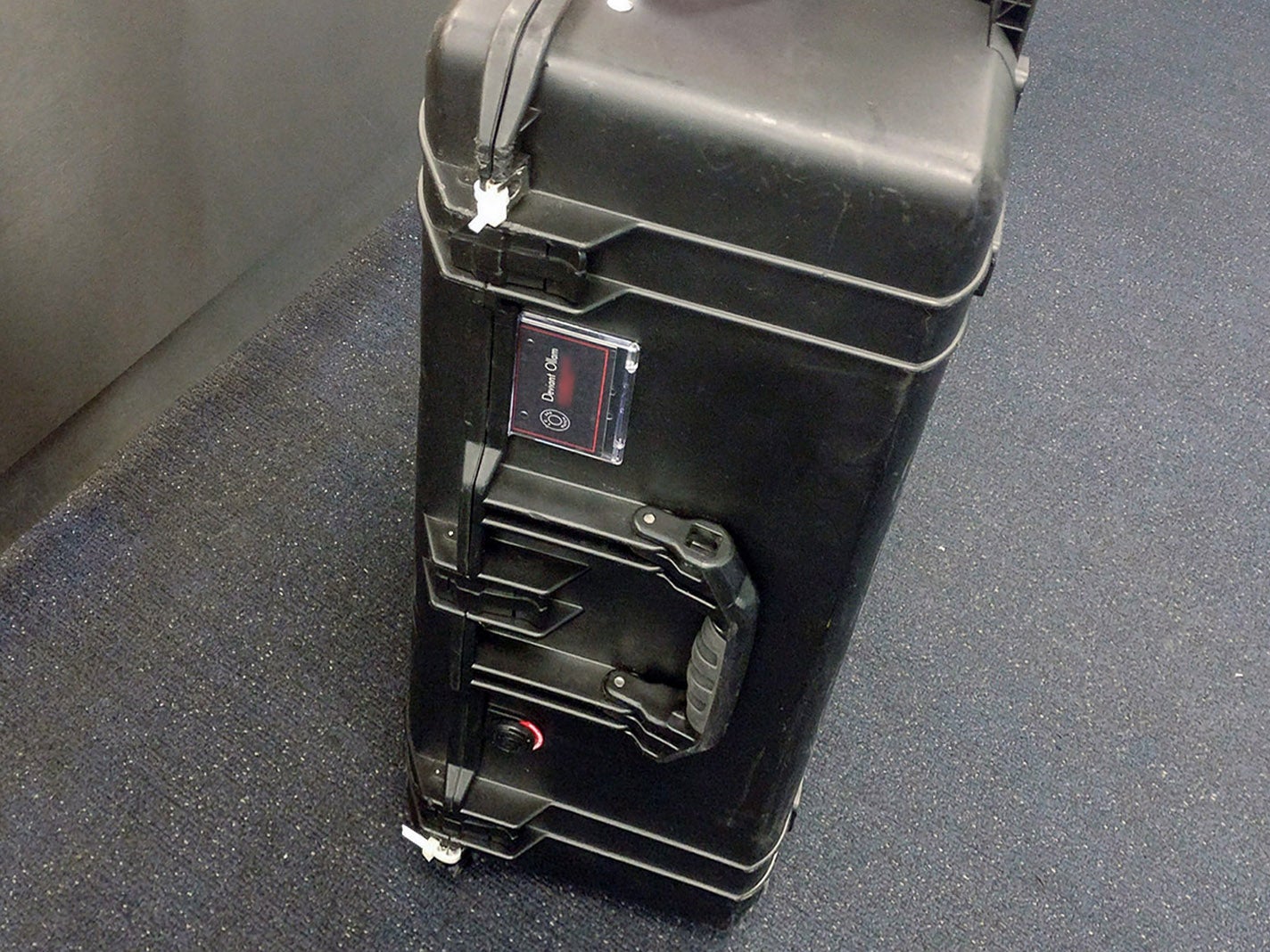
Author’s firearm-bearing Pelican case which has had its locks cut off and replaced with zip ties.]
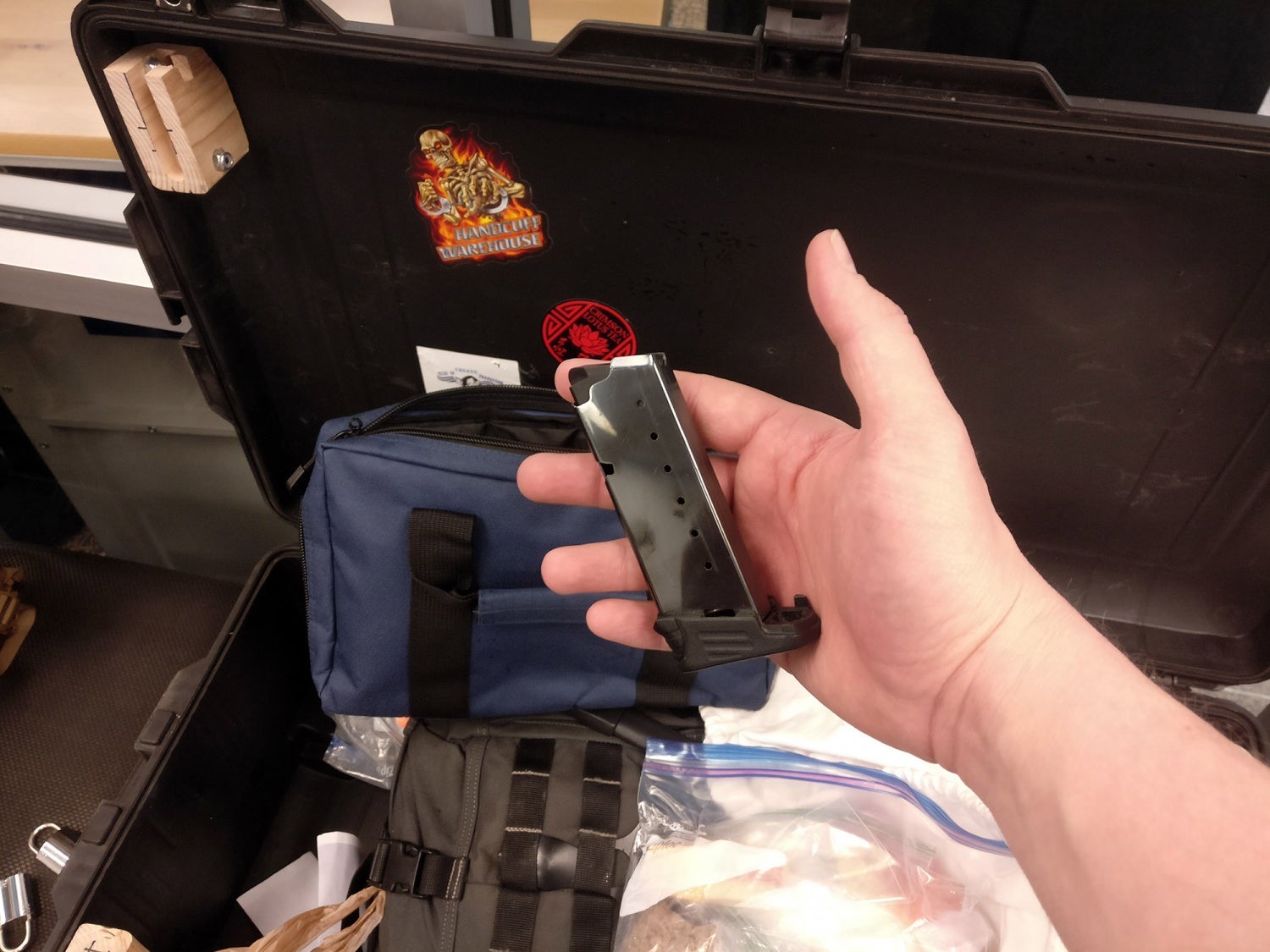
One time, for reasons beyond all comprehension, magazines in the author’s range bag had their ammunition removed. The magazines were not inserted into any firearm and were being transported in enclosed pouches, in accordance with all proper regulations. You’ll recall from the video above that Delta supervisor James in Orlando refused to contact the TSA and assured us that the locks would not be cut off if they needed to open any luggage for screening.
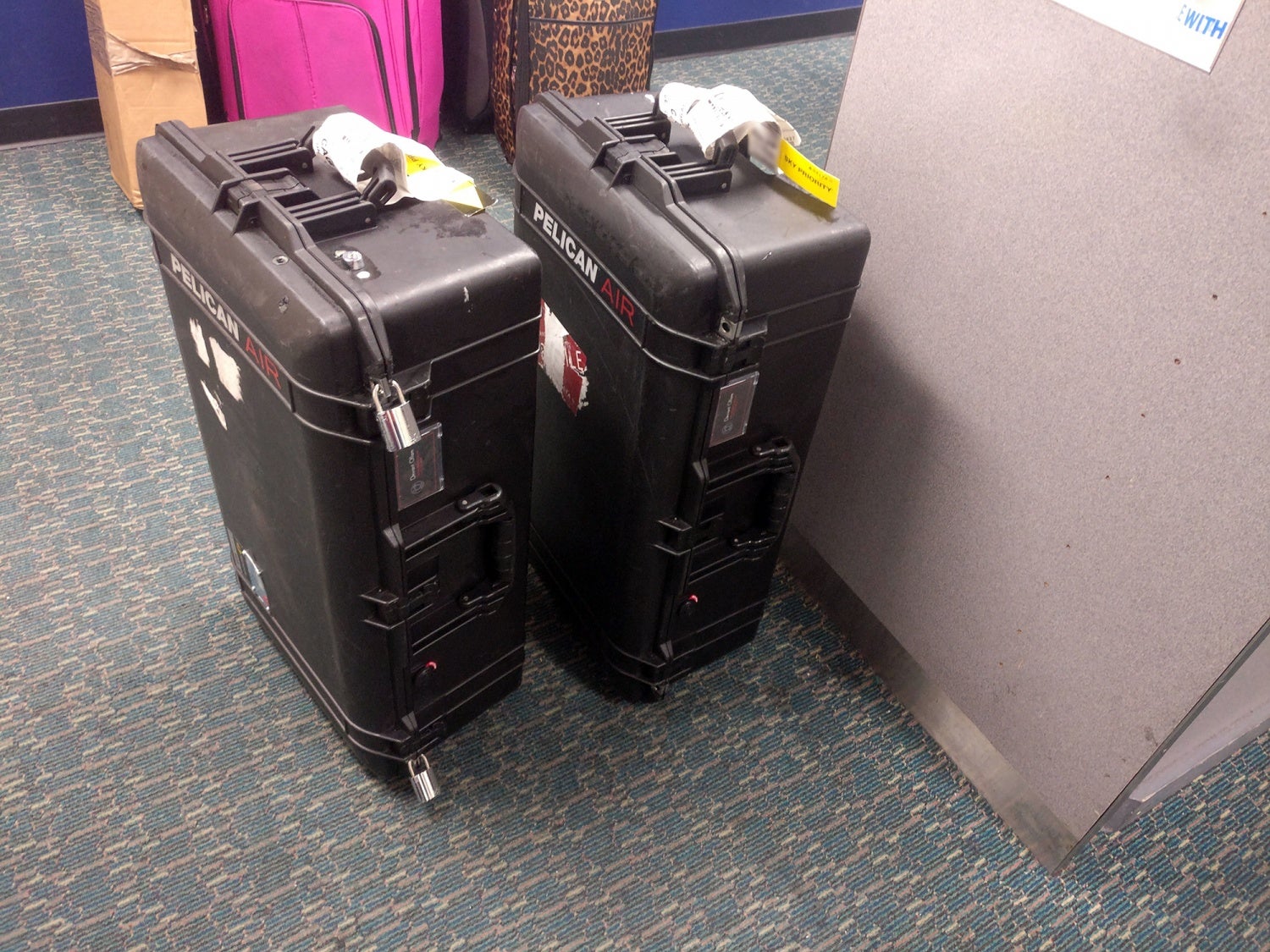
Upon a different arrival in Orlando it was discovered that TSA workers at Las Vegas’s McCarran Airport had cut the locks off of one of the author’s gun cases, but not the other… this after Delta employees Loren and John in Las Vegas offered assurance that the luggage had cleared.
Hopefully, if you follow the advice that appears further along in this article, you can prevent such over-the-top mishaps on your travels. And, let’s be clear, the majority of my flights with firearms have been relatively without incident. In 2017, I took 91 flights. All but 8 of these involved checked firearms. There were 4 incidents of locks being cut and gun cases being opened.
When Firearms + Airlines = Difficulties
Much of the time, the hassles you will face when flying with firearms are far more mundane and easier to handle than destroyed locks. While the TSA remains the prime villain in the most severe of incidents, inconsistent airline policies are what you are more likely to encounter. One such example pertains to finding yourself in the middle of an open itinerary: if you are marked in the system as having checked a firearm on the first leg of your journey, some carriers will flag you for special treatment and require in-person check-in at the counter for continuing legs of travel (whether or not you plan on having a firearm in your bag for the rest of your journey.) Do not be surprised if automated kiosks or your smartphone app refuses to let you check in if you are flying with firearms.
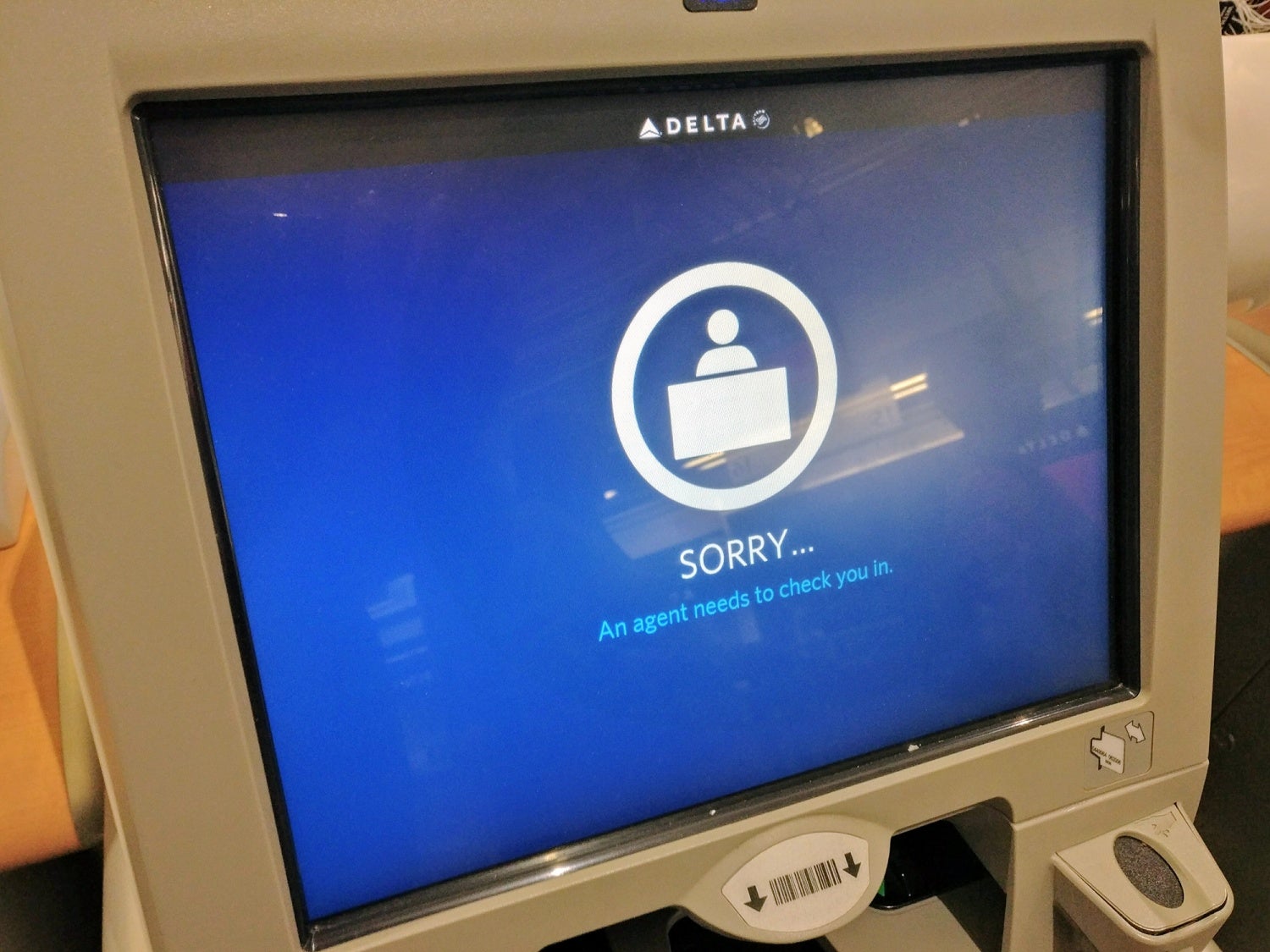
Get used to seeing this screen a lot if you fly with firearms. For people like this author and his wife, who are both Diamond Medallions on Delta, approaching the counter isn’t all that daunting. The rest of us, however, have to leave a little extra time in our schedules or pray for short lines in the check-in hall.
Another unpredictable variable alluded to in the first article of this series, is where your gun cases will arrive at their destination. More and more, airlines have started to express a preference for holding firearms at the Baggage Service Office in the destination airport. Still, such a system relies on rampers noticing which luggage is slated for special treatment and pulling it separately from the baggage carts. Many times, this won’t happen, and your firearms will make an appearance on any number of possible bag belts. If you have friends or family with you, I recommend fanning out so people can keep an eye on the regular carousel as well as the oversize luggage areas. If you’re flying solo, good luck.
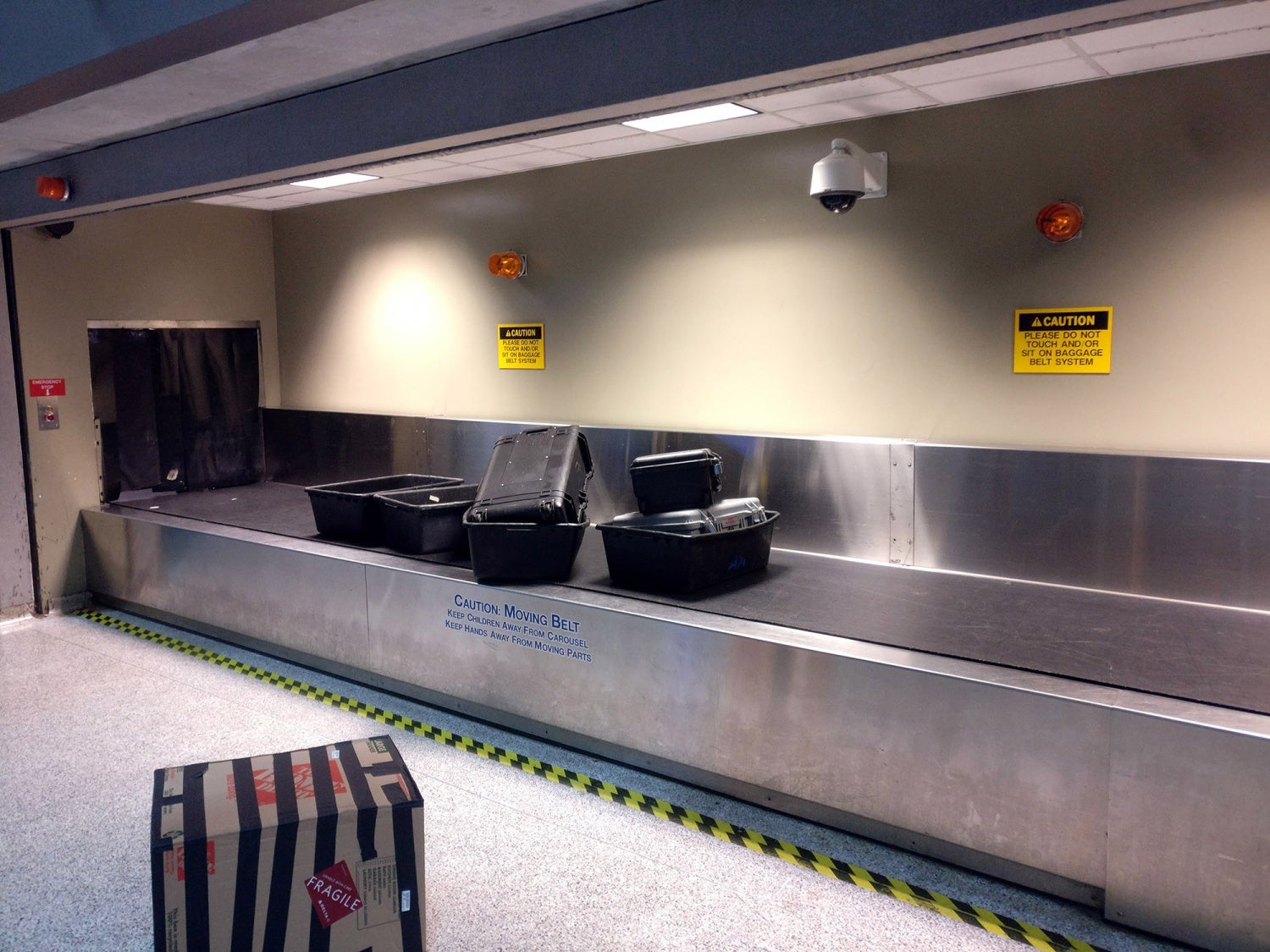
Delta Airlines has a policy that firearms should always be held at the Baggage Service Office and claimed thereby the passenger, who must show ID. That’s all well and good, but across all flights in 2017, this author’s firearms only went to the BSO 74% of the time. 28% of the time, some or all of the guns would appear on unattended baggage belts in the claim area. (Percentages may seem imperfect. On several occasions, some gun cases on a flight would be pulled by rampers but others would not be.)
When FireaRms + TSA = Nightmares
As mentioned previously, my colleagues and I have had locks cut completely off of gun cases by TSA screeners. Arming under-trained government minions with bolt cutters, an overblown sense of duty, and little common sense has led to this eventuality for a number of citizens who fly with their firearms. To be clear: current law and policy states that if the TSA has a “need” to open a piece of luggage for security screening, they are allowed to do so. Ostensibly they are supposed to make a good faith effort to reach the passenger first, but in my experience, this courtesy is seldom attempted. After all, as you can see in the photos that accompany these articles, all of our family’s Pelican cases have prominent tags affixed directly on the outside bearing our names and phone contact information… yet never once have we gotten a call before they have broken into our bags.
Certain airports within the USA seem to have taken every step possible in architecting their design and operations in a way that precludes any feasible or smooth communication between the TSA, the airlines, and ultimately the passengers if a piece of luggage alerts and may be subject to inspection. One such infamous location is Boston’s Logan airport, where bag screening happens at “the shack”, a TSA depot described as “unconnected from the terminals” by anything other than automated conveyor belts. MassPort authorities have admitted, when one associate of mine pressed them on the matter in the course of investigating his own instances of locks cut off of gun cases, that allegedly there is a policy in place whereby TSA employees should call the airline and then the airline should page a passenger if a key is needed. In practice, however, it is widely acknowledged that this process frequently breaks down and that the TSA regularly hides behind the excuse of “time constraints” while cutting locks off of luggage, including gun cases, in Boston.
Blame for relying on the “there’s no time” pretext when locks are cut does not solely rest with the TSA in all instances. When I was departing San Diego in May of this year, after I spent almost a full hour trying to convince anyone from Delta to confirm with the TSA that my luggage had cleared, LTSO Figueroa came and found me in the terminal saying that both of my gun cases had alerted and they needed my keys. He reported that the TSA had “been calling Delta for half an hour” with no luck. I was not the only individual with a gun that didn’t clear screening that day. There was another passenger in the gate area who had checked luggage they wanted to open. TSA had their name, but when Mr. Figueroa asked the Delta gate agent, Barbara, to page them, he received the curt reply, “I’m very busy right now,” and she then coldly asserted to him that they should, “just break open the luggage.” (A Red Coat supervisor at SAN, Heidi, later sought to assure me that this was absolutely not proper Delta policy, that the passenger should have been paged, and that no one from Delta should ever take such a cavalier attitude toward cutting the locks off of luggage.)
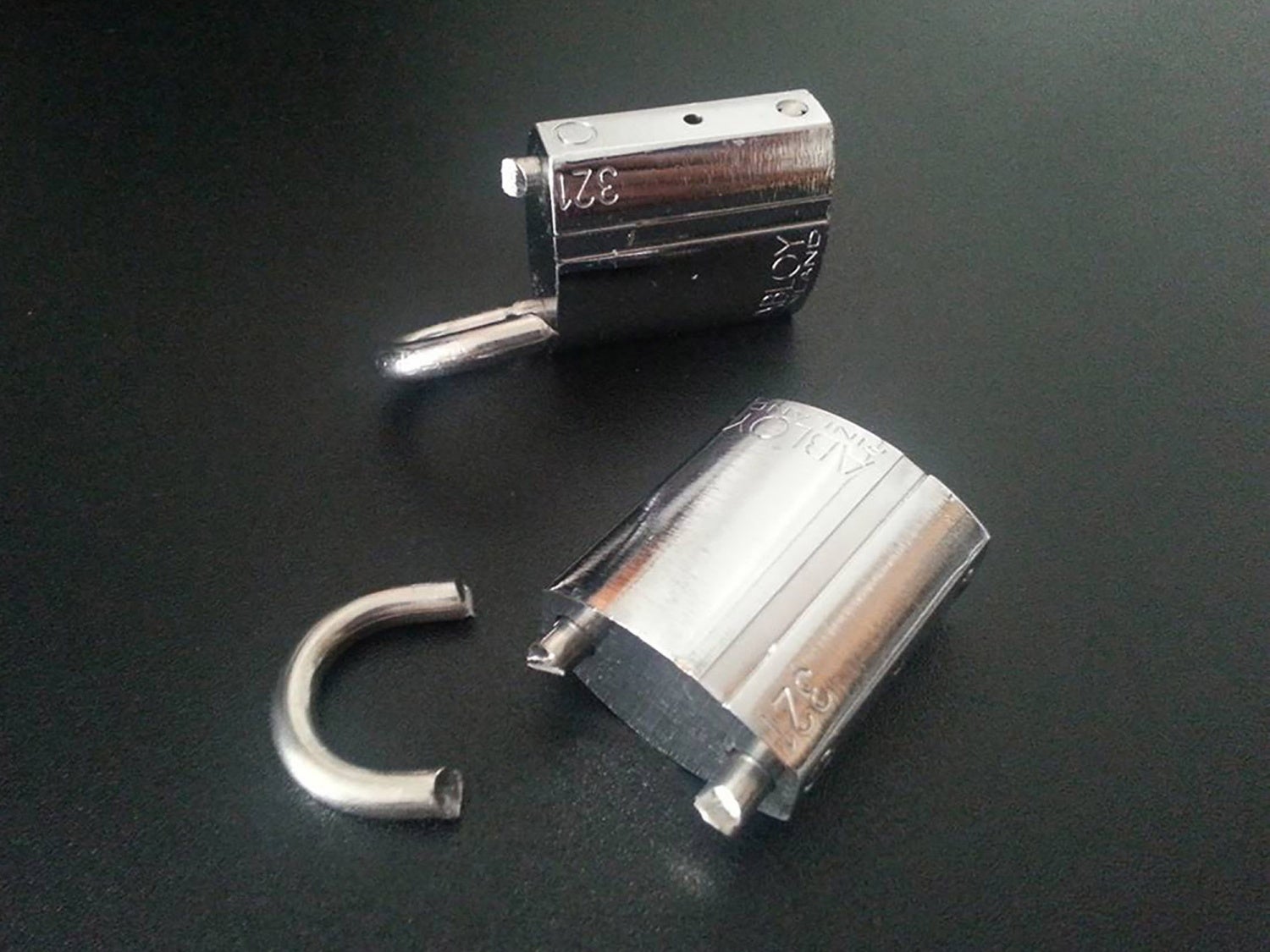
A pair of Abloy Executive Travel Locks which were cut by the TSA (and then placed inside of the author’s Pelican case) on a flight from Honolulu in 2016.
I originally selected the padlocks I often use on my Pelican cases because they are lightweight, yet still offer extreme resistance to covert or surreptitious entry… as long as I see the locks still affixed at my destination, I have very high confidence that no one has been inside the luggage. (I also frequently use this “security seal” functionality when stowing valuables in my Pelican case in a hotel room or Airbnb.) This model of padlock is, however, susceptible to large bolt cutters.
Some travelers who fly with firearms take a different approach, opting for very heavy-duty padlocks which are almost completely invulnerable to bolt cutters, saws, or any other implements that the TSA may have in their back room toolboxes.
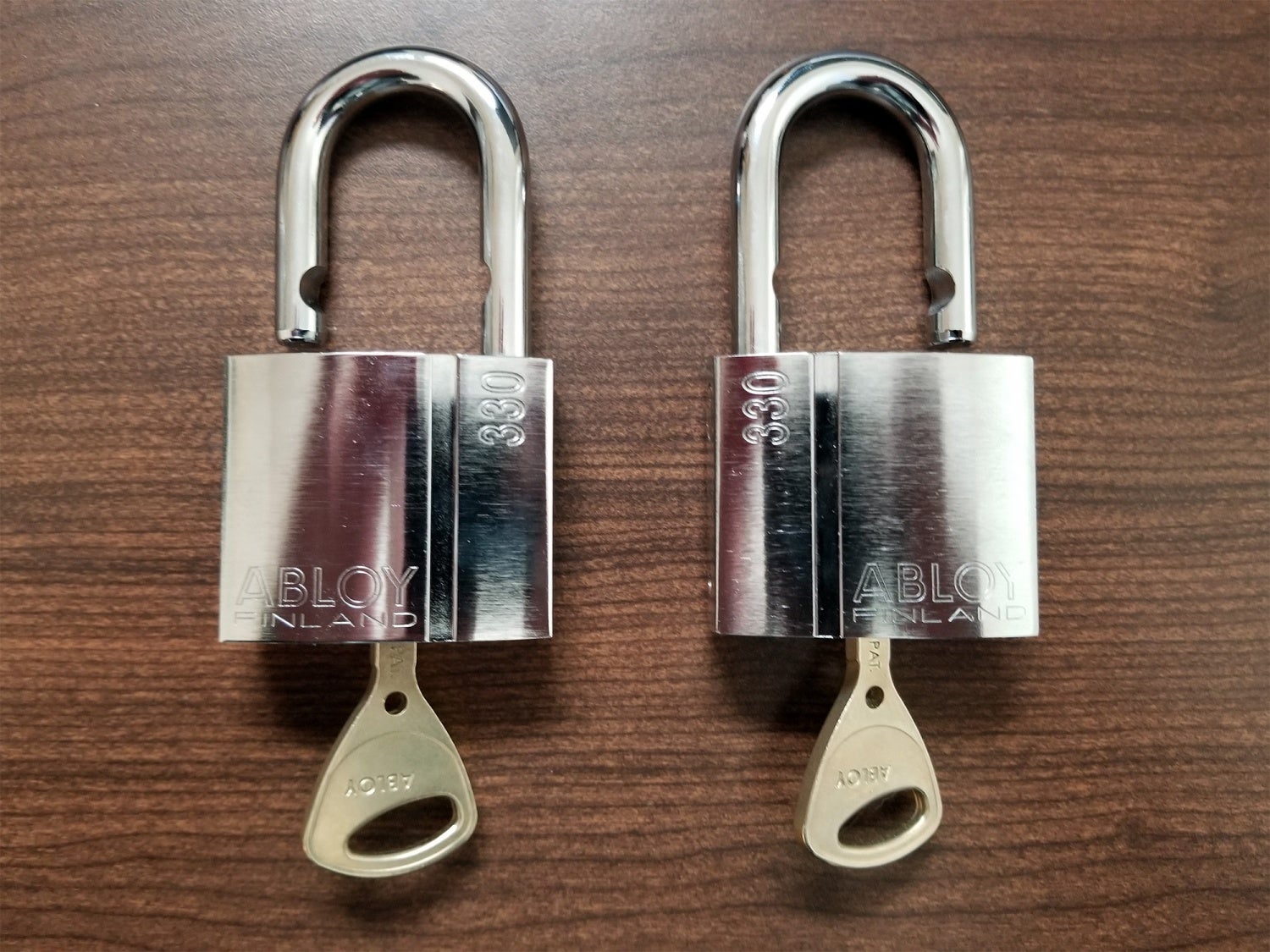
Some travelers who fly with firearms opt for heavy-duty locks such as these. Nothing the TSA has at their disposal is likely to get through the hardened boron shackle.
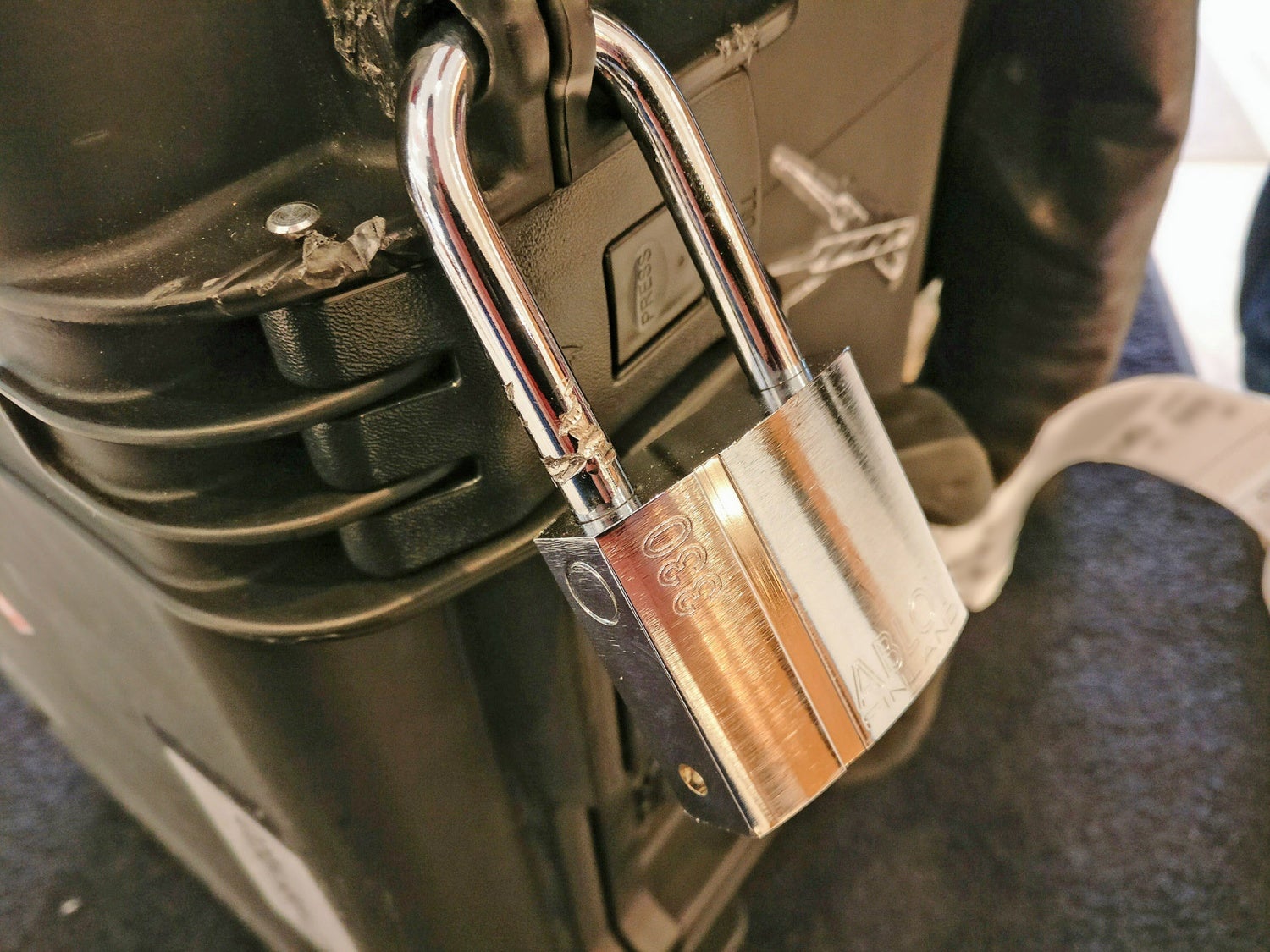
The TSA apparently tried, and failed, to cut off this padlock in Boston. Remarkably, despite initially wanting to get inside of this gun case, they sent it along to be loaded on the passenger’s flight anyway.
Some travelers opt to use heavy-duty locking solutions that airport staff cannot penetrate, in an attempt to force the TSA to locate and contact the bag’s owner instead of just blindly destroying individuals’ personal property. This is a fine life hack, and you can on occasion indulge in the satisfaction of having spoiled a government flunky’s afternoon when they must admit defeat and contact you, but be aware that if a bag is unable to be opened, the chance also exists that the TSA will just not allow it to be loaded on to an aircraft. There is no guarantee they will contact you at all… you might simply arrive at your destination without any luggage showing up. Then, a series of confused phone calls between your air carrier’s baggage handling departments will reveal that your luggage never left its point of origin. And now, being unopenable, there may be no feasible means at all to allow it to catch up with you. So, use caution.
Ultimately, the best way to overcome problems with how the TSA treats your gun cases is based around taking an active role in ensuring that your luggage has cleared security before proceeding on to your gate for boarding. How you go about doing this depends on what type of luggage screening arrangements to which firearms are subject at your point of origin. There are three basic scenarios…
1. Direct Interaction with the TSA
The most ideal baggage screening process, if you are flying with firearms, is one in which you are present and interacting directly with the TSA employees who are clearing your luggage for air travel. Sometimes (often at smaller regional airports) there may be a screening area right there in the check-in hall adjacent to your airline’s counter. Other times, you may be directed to a “special luggage” screening room a short distance away. The actual luggage processing may involve x-ray machines, chemical residue swabbing, or a hand-search… but being able to directly observe what is happening and then being given a reassuring wave by the TSA employees is the best possible arrangement if you want to guarantee that your luggage will be subject to no additional hassles on your journey.
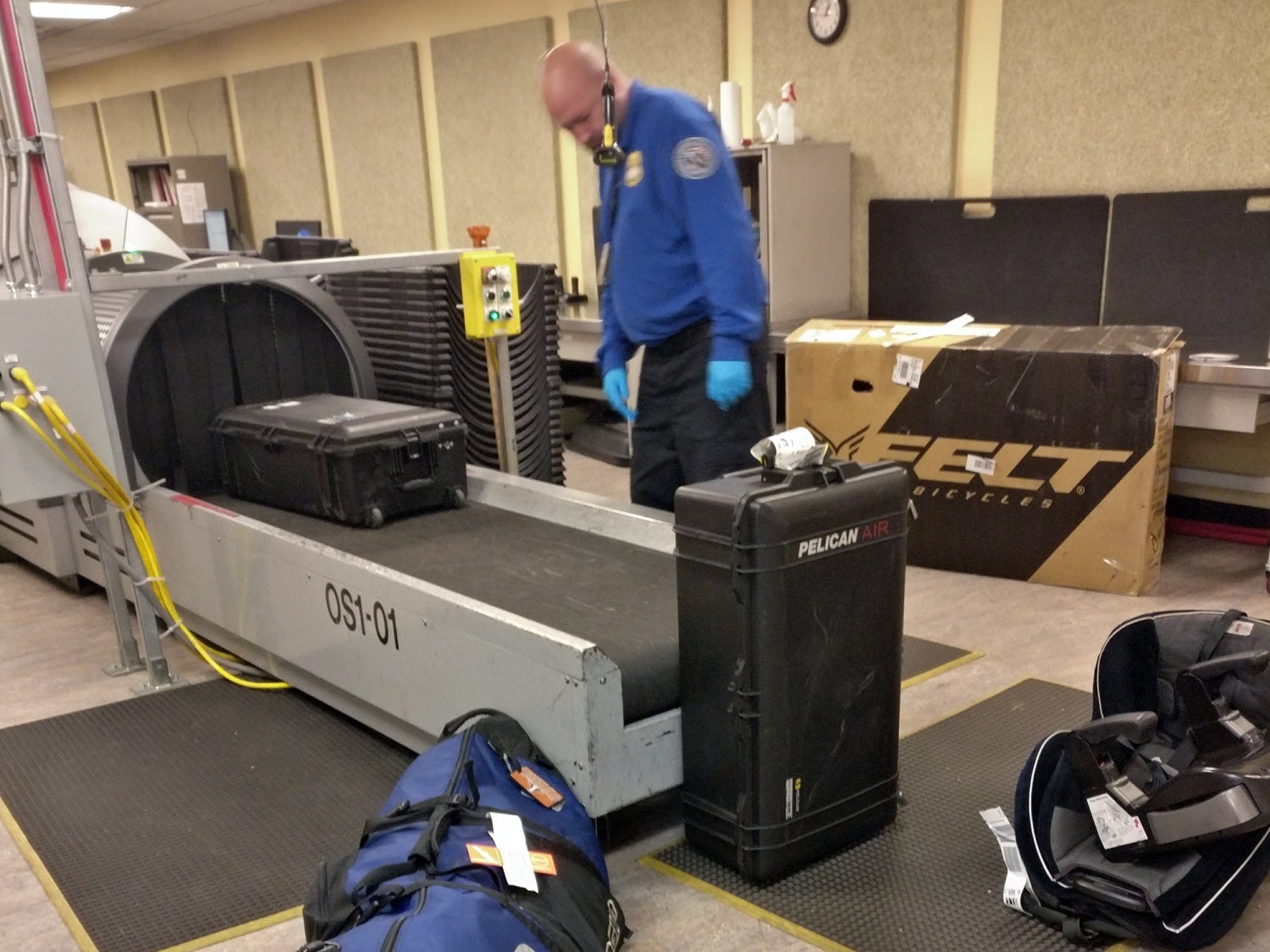
Being able to directly observe your firearm cases during screening and being afforded positive confirmation from the TSA folk performing the task is the best case scenario if you want to prevent your locks being cut off.
2. Indirect Interaction with the TSA
Sometimes you will not be permitted to be immediately and directly present in the same space as your gun cases during luggage screening, but you will know where this process is taking place and the TSA will be aware that you are nearby, waiting for confirmation. Perhaps you’re looking through glass in a door or maybe you’re with an airline worker is communicating through flapping rubber curtains to TSA in the next room. This may not give you 100% confidence that your luggage will be re-packed properly if they have to open it in order to clear an alert, but at the very least the TSA will be aware that the passenger who owns the bag is right there should they need to open it. After a thumbs-up from someone through a window or a “this one’s all set!” shouted from the other side of a swinging door, you should have decent confidence that you’re ok to head to your gate.
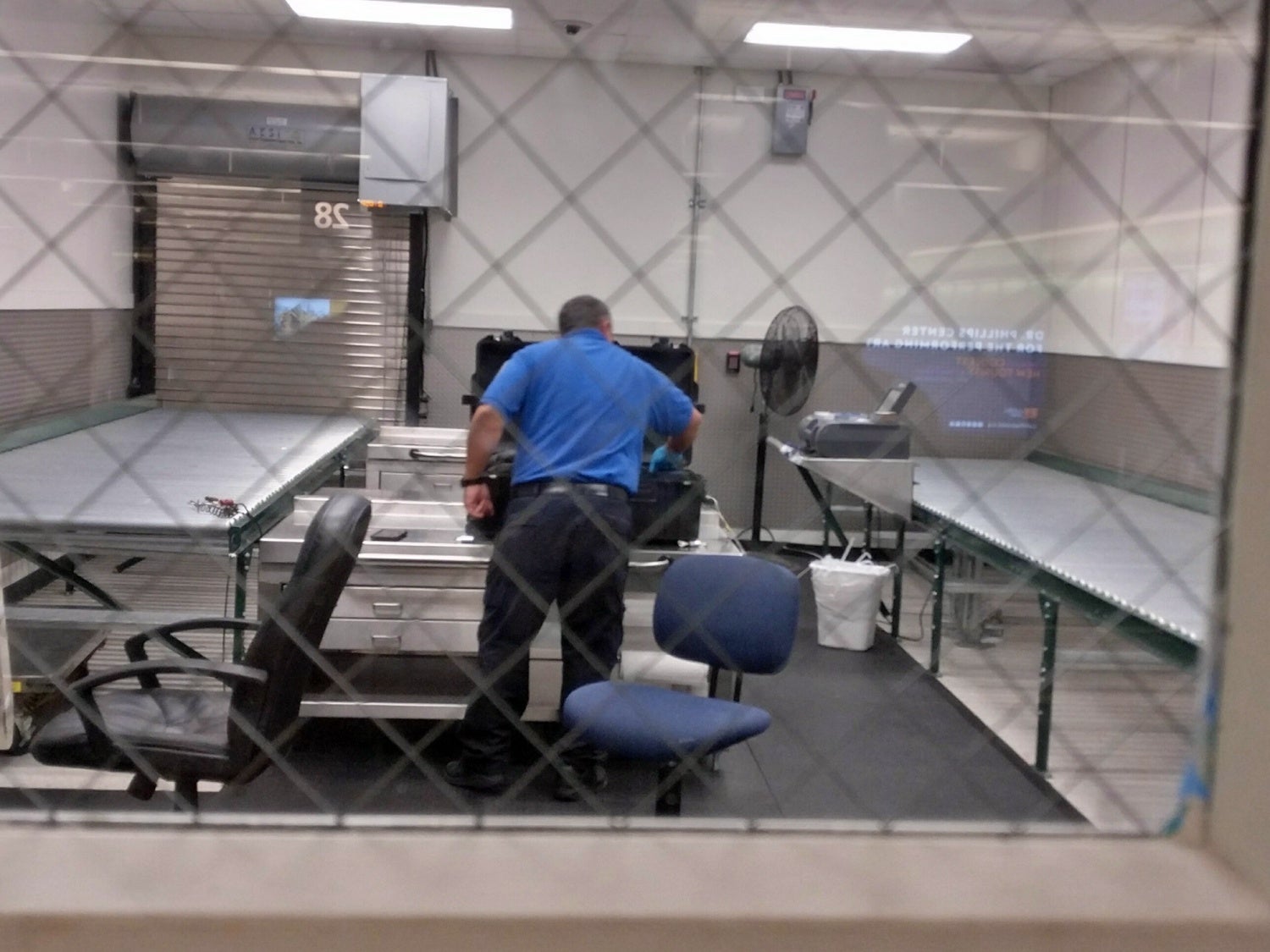
While this particular fellow didn’t have the same Tetris skills that as the author, eventually everything was repacked into the gun case and the key was handed back out through this door with a pleasant “everything is all set” remark.
3. Zero Interaction with the TSA
This is the biggest recipe for trouble when it comes to flying with firearms, and wholly all of the times when I, my wife, or my business partners have had locks cut off of gun cases, it has been this type of operation at the origin airport. Many of you out there who have flown with guns previously will have encountered this scenario: you check-in at the counter, the airport staff tags your guns and sends them back on the belt, then says something like, “Wait about ten minutes here and if no one calls you on the PA system then you should be good to go to your gate.”
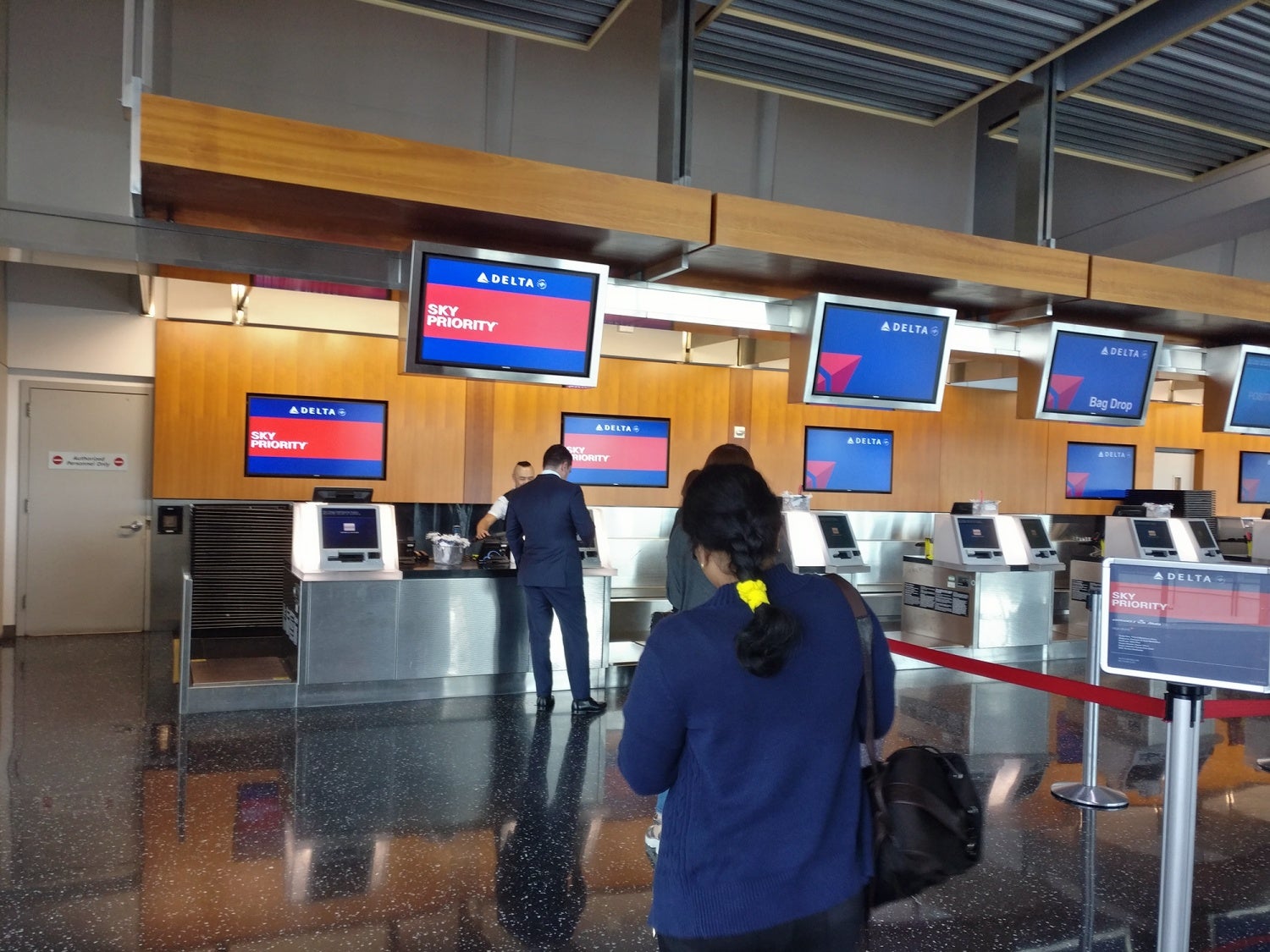
The worst-case scenario when it comes to firearm screening: Your luggage goes back on a belt and the counter staff tells you, “Stand around for a few minutes and we’ll call for you if the TSA needs your key.”
Steps to Take to Avoid Trouble
If you listen to absolutely nothing else I have to say in this article, I would urge you to pay attention to this: you should never simply wait the suggested ten or fifteen minutes and then silently proceed to your gate. Always walk back up to the counter. Demand assurance that your luggage has cleared TSA screening. Communication between the carriers (or at least their front line counter staff) and the TSA is abysmal in many airports. Do not be surprised if the person whom you are addressing at the counter offers an apology and the excuse of, “We don’t actually have a way of contacting the TSA from here,” or, “They’re the ones who call us if there’s a problem. If they don’t call us we just assume everything is OK,” or something similar.
Stand your ground. Ask to speak with a supervisor. Force the airline staff to get in touch with their operations office. Even if they ostensibly have no means of contacting the TSA, ask if they will call to their Bag Room or Luggage Operations desk. It may be possible that way to determine that your gun case is now in the hands of rampers and throwers and not stuck somewhere in the screening queue.
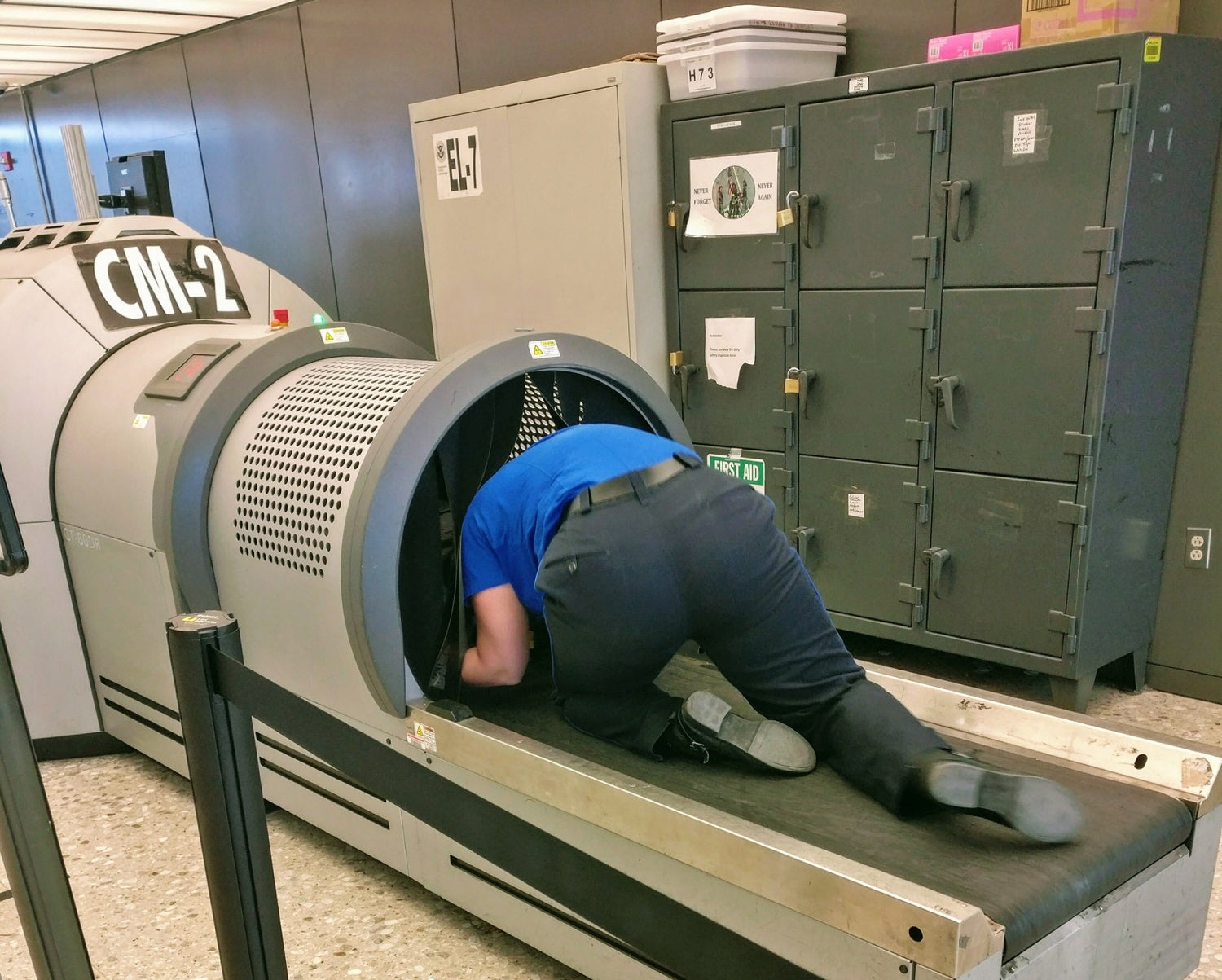
Airlines like to assert that the TSA processes all luggage quickly… but sometimes things go awry. Don’t leave the check-in hall until you know for sure that your luggage has made it all the way through TSA screening.
One reader wrote to me and described in detail an instance where he diligently inquired with Southwest agents about how they handle firearms screening in Detroit as he checked-in for a flight to Houston. Despite repeated assurances from airline staff saying he was all set, this passenger heard his name called over the PA system a full two hours later while in the terminal. The TSA wanted to open his luggage, did not want to go to the trouble of calling him on his phone, and opted instead to break the Pelican case. Only upon reaching his destination did this flier understand the extent of the damage to his property.
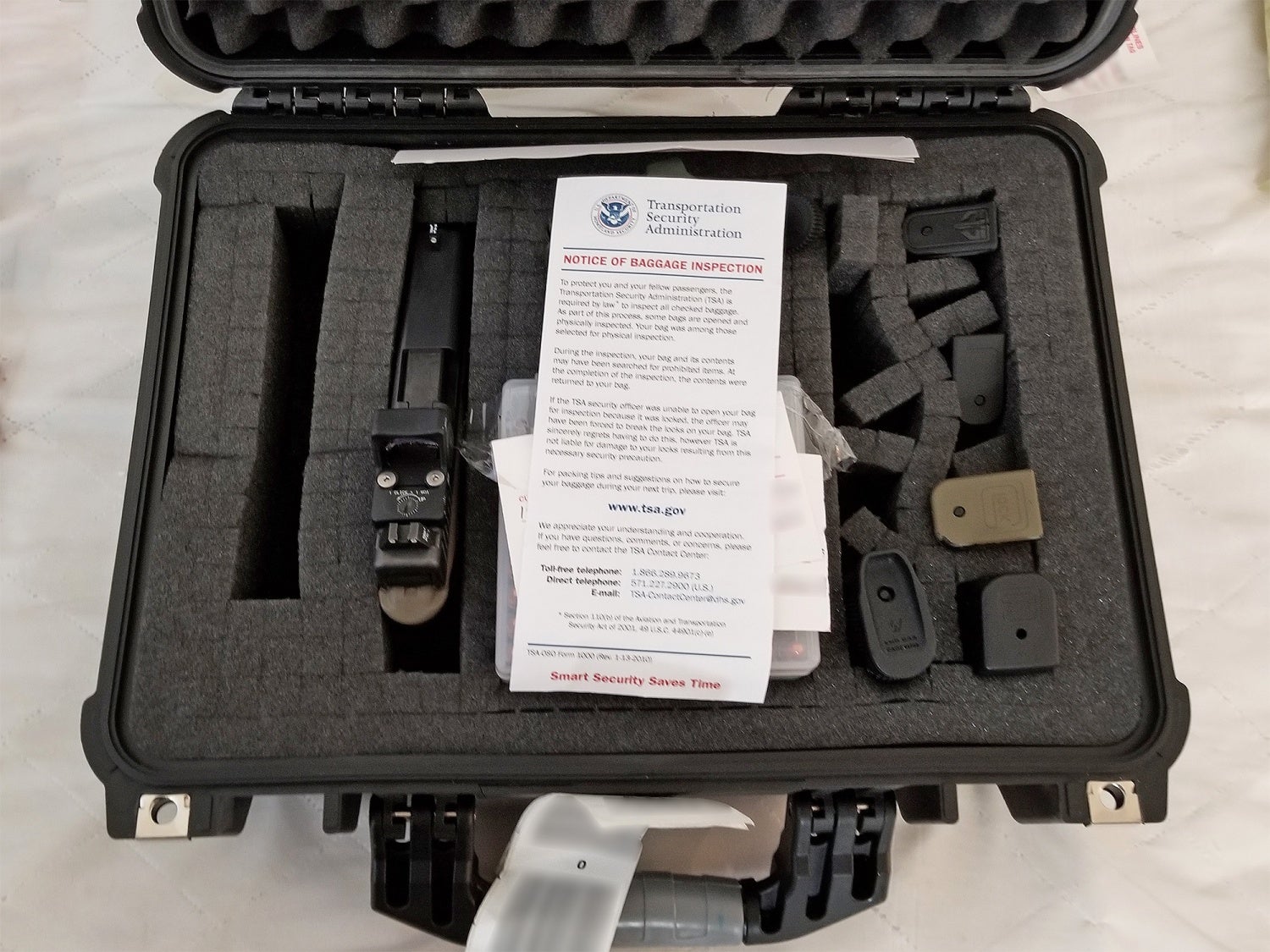
The owner of this Glock was astonished to see a TSA love letter inside his gun case when he made it home. He hadn’t received any call from the TSA or his airline. The heavy duty Abloy PL330 locks he was using are not susceptible to bolt cutters, shims, or other tools that the TSA may have considered using. He could not imagine how they had accessed the inside of his gun case.
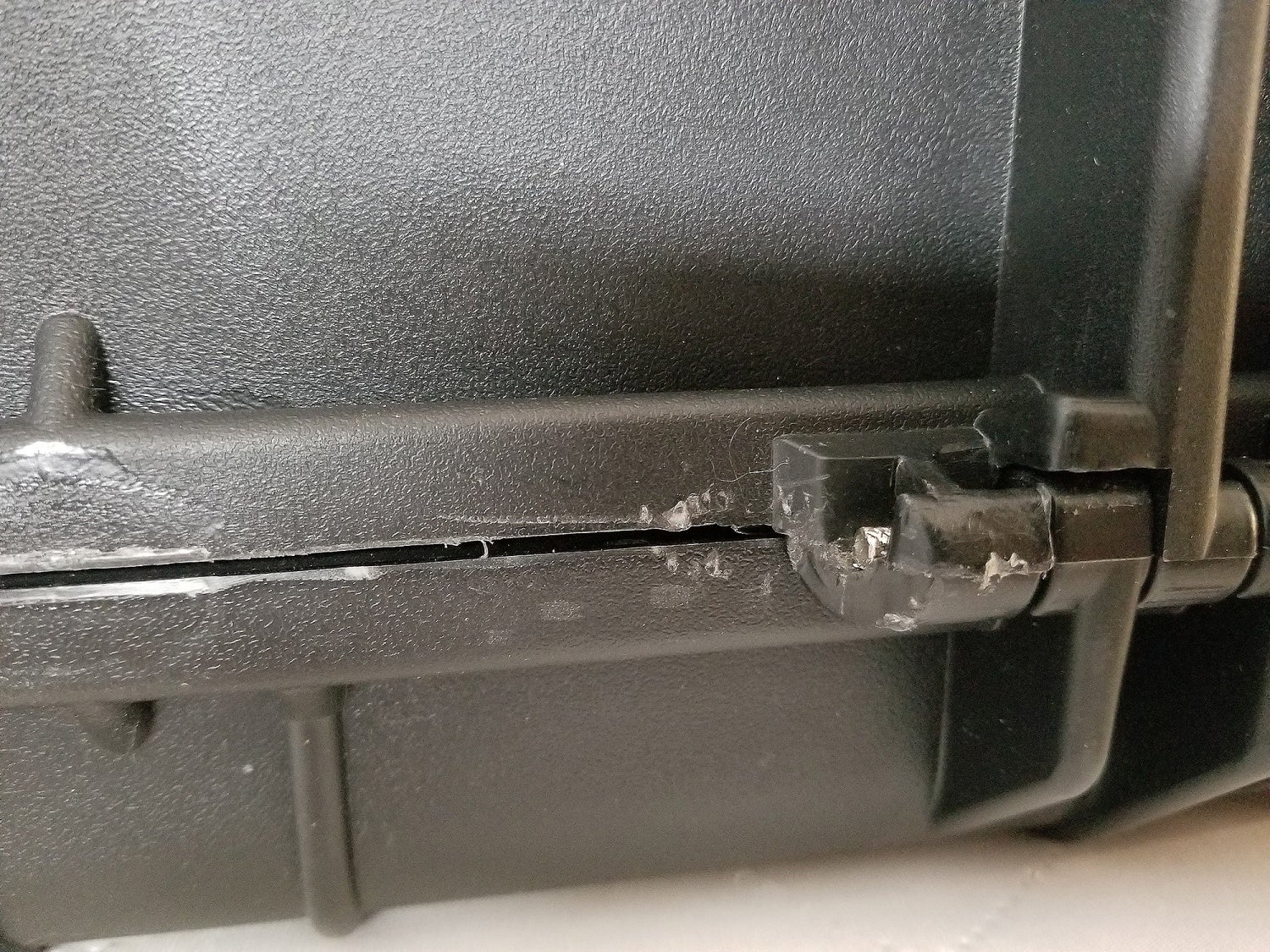
Only upon closer inspection could the owner of the Glock in the previous picture discern what had happened. The TSA, having no ability to break through the Abloy PL330 padlocks, opted to destroy the hinges of this traveler’s Pelican case by cracking plastic and pounding out the pins, which they later attempted to re-insert, imperfectly.
This individual had opted to use heavy-duty padlocks which the TSA was not able to cut, a fact which led to another interesting detail he discovered came during his follow-up conversations with frazzled and apologetic management types. The TSA supervisor in Detroit admitted that had the case been metal on all sides, they would not have attempted to cut it to gain entry. But, whether the luggage would have then been permitted to fly at all is uncertain, as we discussed in an earlier section. This situation illustrates perfectly why “just wait fifteen minutes and then go to your gate” is not what you should do. Demand that your airline’s check-in staff provide you confirmation that your firearm has cleared TSA.
If ultimately the employees before you remain unmoved, it falls upon you to determine just how large a grain of sand you are going to be in the cogs of their machine that day. How long are you willing to stand there? How assertive are you prepared to be in conveying to them that you do not feel they are adequately doing their job? More than once, I have leveraged my persistence as well as my refusal to simply go away to become someone else’s problem. Eventually, airport employees have been forced to learn that it was indeed possible to reach the TSA screening room or otherwise confirm a gun case’s progress through the baggage system.
Related to this is another tactic I recommend: take notes to yourself during travel. You don’t have to be as fastidious as I often am, but using a smartphone app to jot down the names of the individuals you encounter (especially if you suspect a problem is brewing) can help you out in the long run, especially if you have to follow-up with customer care or file a complaint about mishandled items.
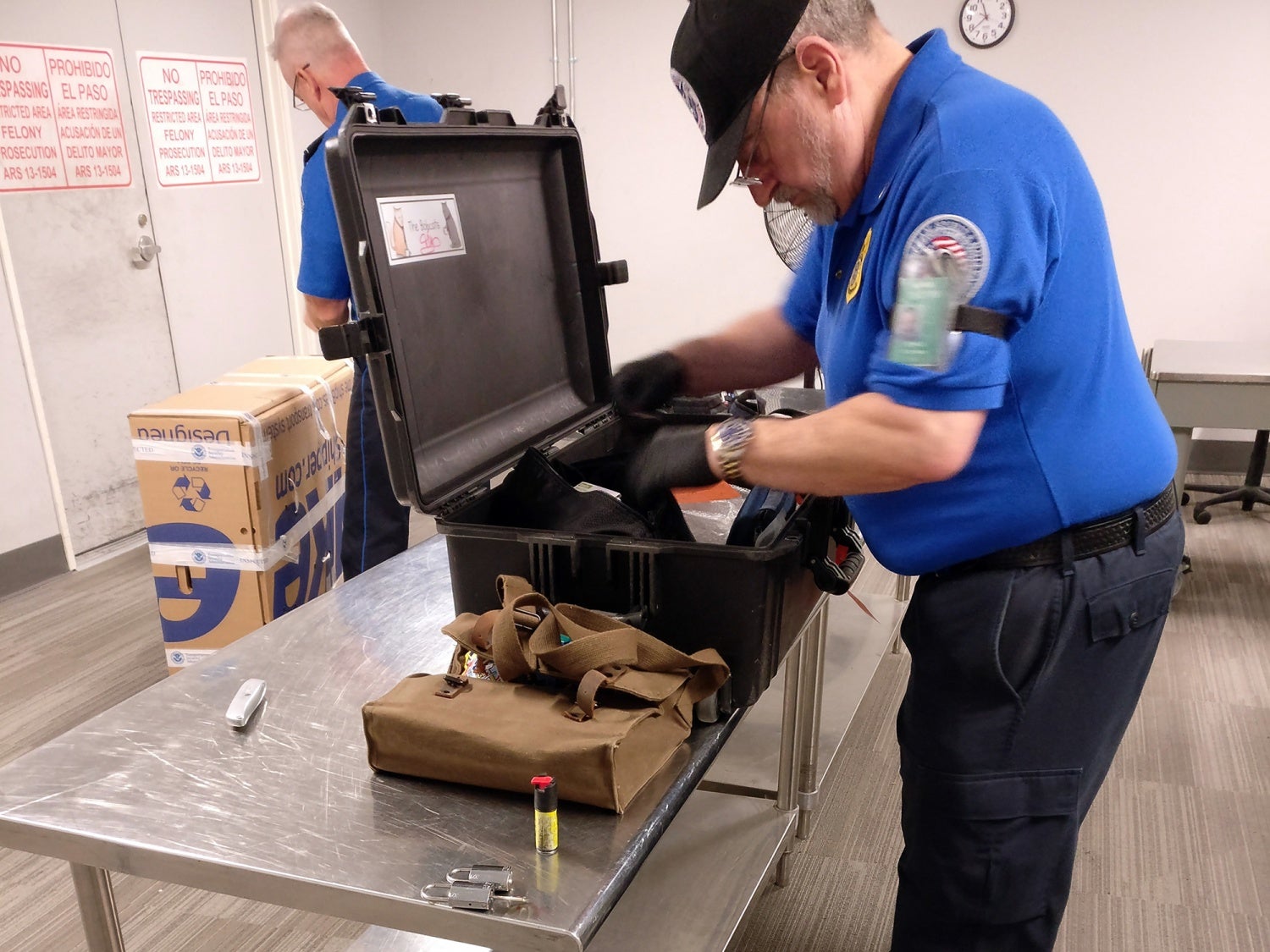
Because I take care to note the names of people who violate regulations, I can tell you that this is Donald in Phoenix who is inappropriately unzipping my range bag and handling my firearms. He also confiscated a canister of FoxLabs pepper spray, despite it being acceptable in checked luggage according to the TSA’s own published guidelines.
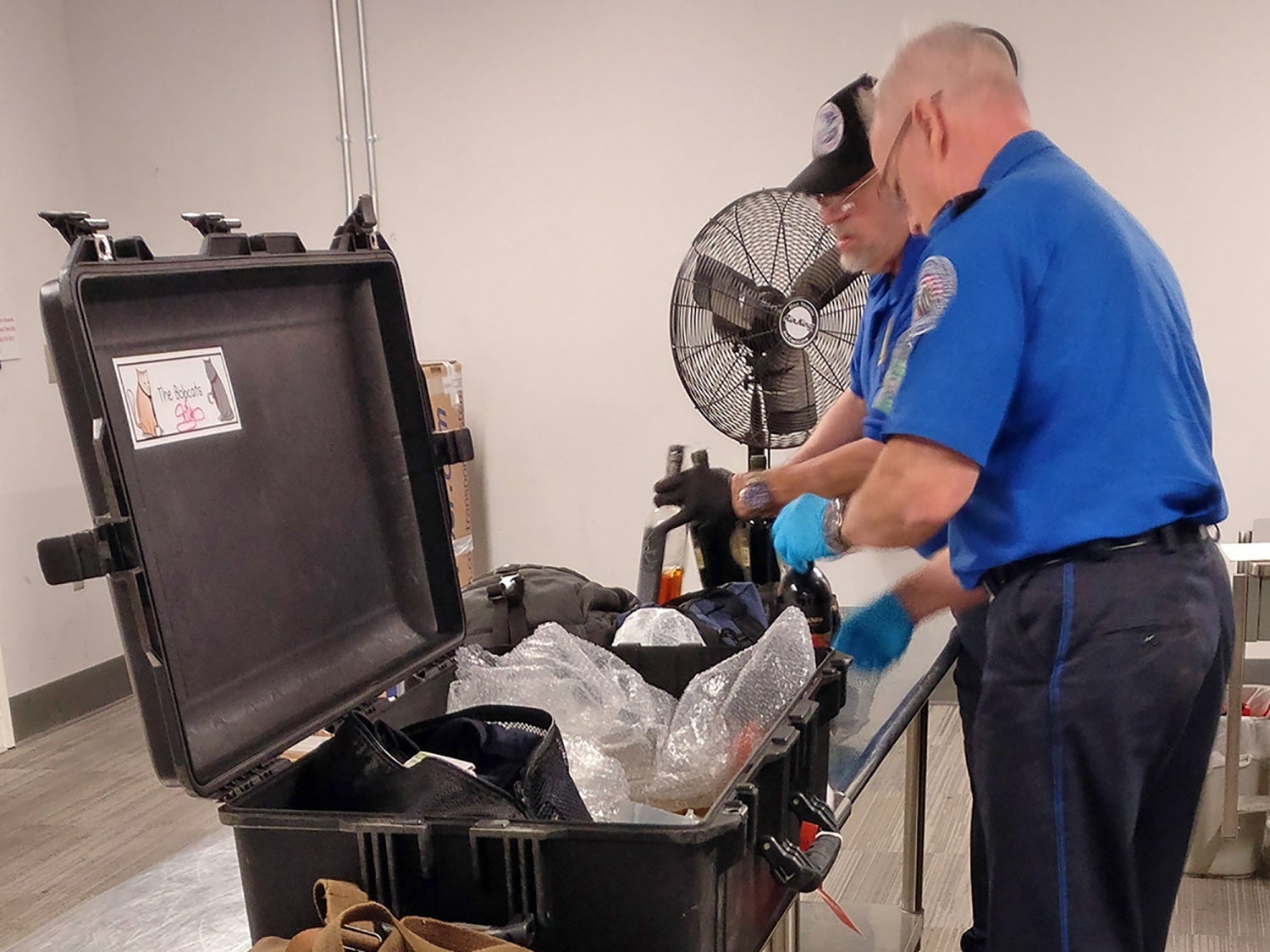
We see that Donald and now Frantz have moved on and are unwrapping every single bottle of whiskey in my Pelican case. No, they did not re-pack it correctly, nor was I permitted to do it myself. It was a miracle that everything survived. Because I had taken names, however, I was able to follow-up with their supervisor at a later date.
If you fly regularly out of particular airports, being observant and getting names or contact information for specific helpful staff members or supervisors can be a good plan. I can tell you that Lillian is by far the most competent Delta Red Coat supervisor in Orlando. We smile every time we see Diane at the Sky Priority desk in Seattle. Back when I lived in Philadelphia, I had the office extension of Robert Ellis – the Customer Service Manager (and then later the Federal Security Director) for PHL International – saved in my phone. In airports where you’re not on a first-name basis with the staff, use keen observation to gather critical contact information.
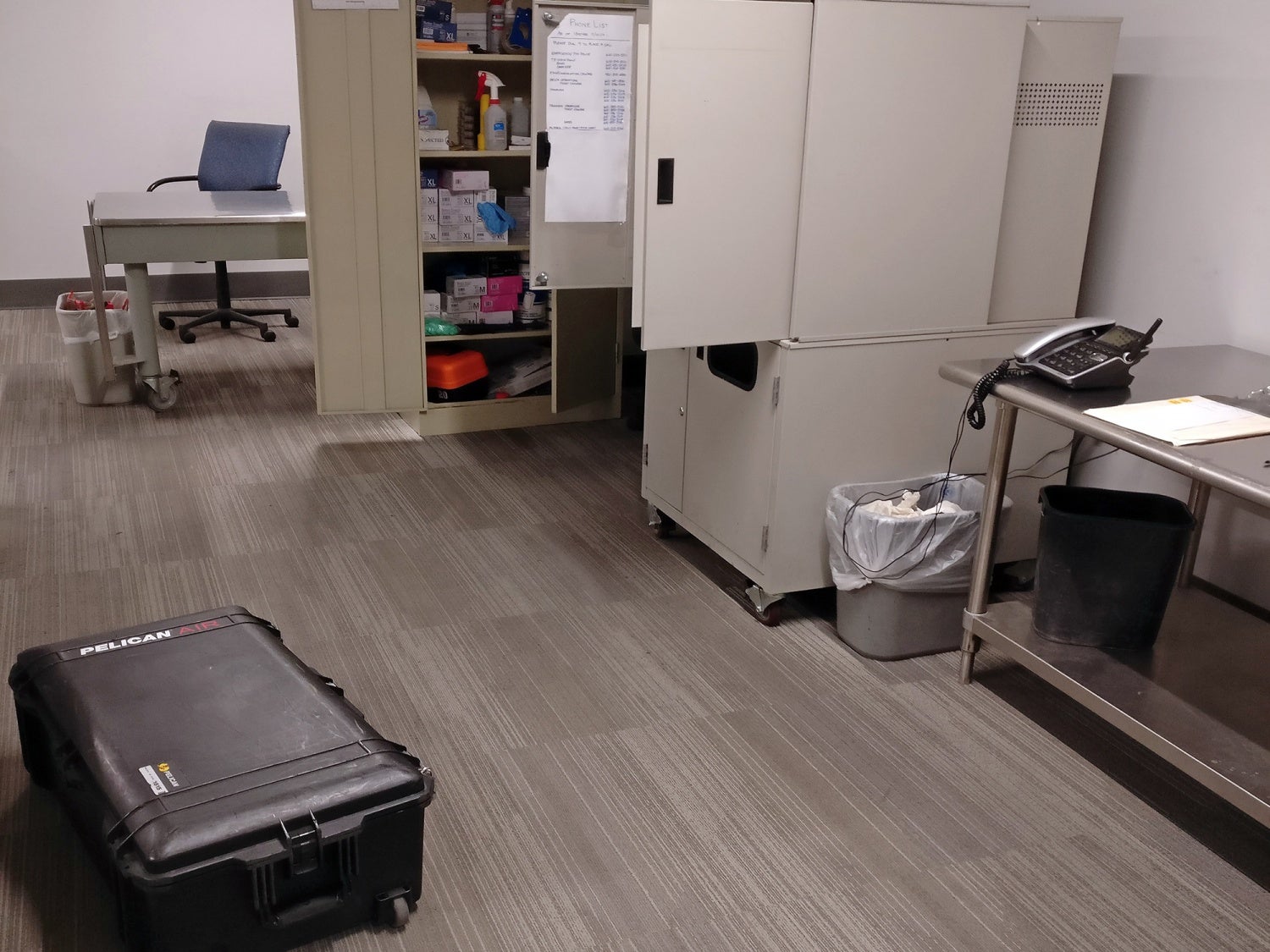
My rifle case is waiting to be picked up by an airport worker for TSA screening. But… what’s that large piece of paper affixed to an open cabinet door? Phone numbers of people to call… Having this airport’s most current phone contact list could prove useful the next time we fly through.
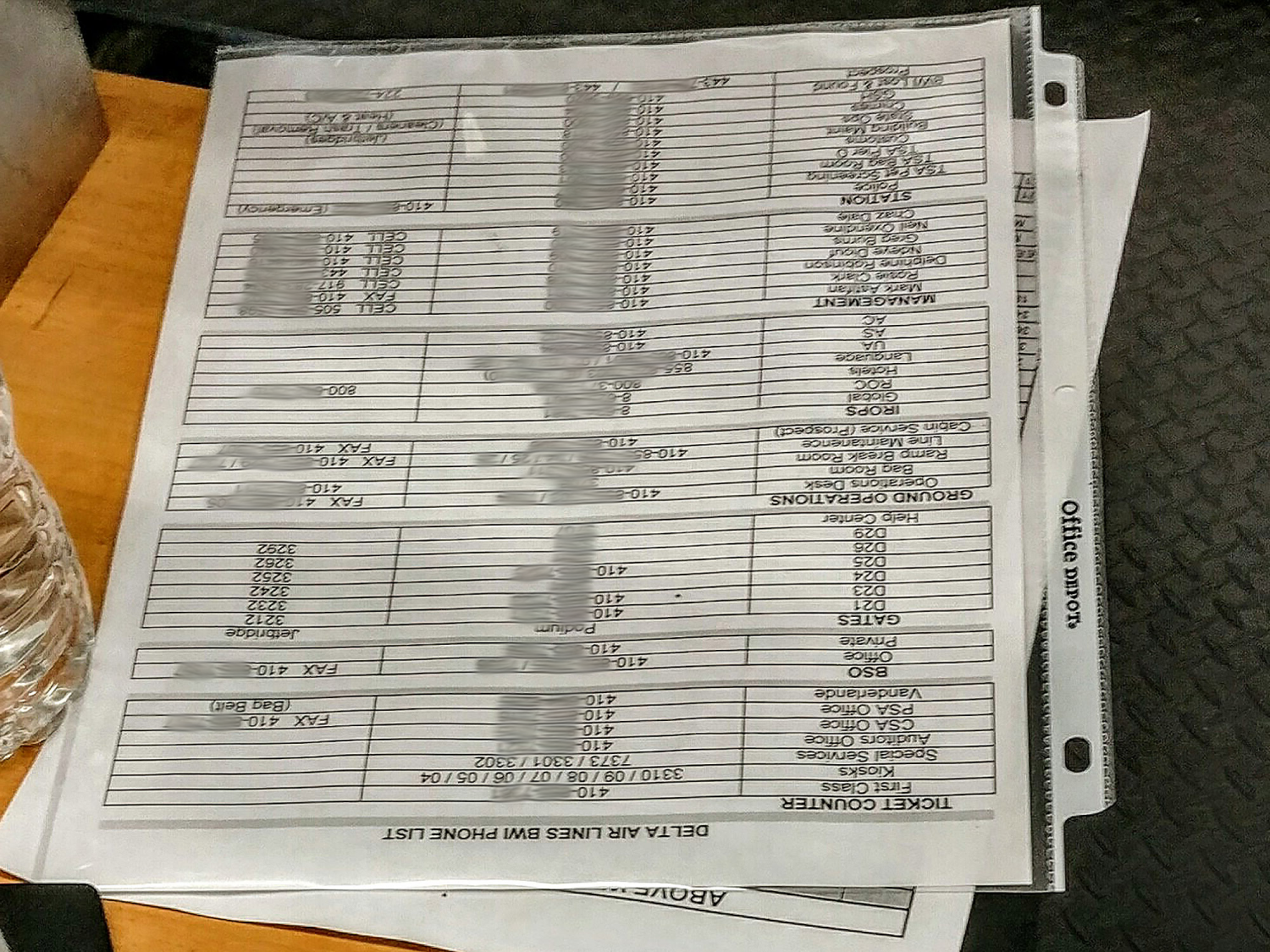
Glance down at the countertop the next time you’re checking-in. You may notice lists of phone numbers and extensions that agents can use in order to check the status of your firearms case. The staff at this counter in Baltimore worked with me as we methodically went down the list, calling the Delta Bag Rooms and then the TSA Bag Rooms in order to figure out whether or not my Pelican cases had successfully cleared.
Could There Be a Better Way?
Hopefully, sharing some of the horror stories we’ve had to endure along with some of the best advice life has taught us while flying with firearms will arm you with some additional tools that can make your experience less likely to go off the rails. Long-term, however, if we wish to see genuinely positive changes for air travelers who have firearms in their luggage, much of what needs to evolve should be driven by the air carriers. There are two significant ways that the airlines could help ensure the safety and security of all firearms which they accept for transport as checked luggage. If more of us were to send feedback to customer care departments, perhaps these measures would be implemented more widely.
1. Send All Firearms to Special Screening
All airports have to offer some accommodations for the screening of special luggage. Sports equipment, oversize items, and live animals in pet carriers are seldom sent down on moving belts. They are handled at a special screening point. As you have seen in this article, it’s not uncommon for gun cases to be processed by the TSA at one of these areas. But, unfortunately, it’s not a hard-and-fast rule everywhere. If the airlines want to demonstrate that they are serious about keeping passengers’ luggage secure when guns are being transported, they would do well to adopt a policy whereby all firearm-bearing bags, regardless of size, should be taken to special screening and not sent down on the belt. (A tip for you travelers: call in advance of a flight and tell the airport you’re planning a flight with a canine carrier as checked luggage. Inquire as to where the special screening area is, how to get to it, etc. Once at the airport, insist on rolling your firearm case to this “special luggage” screening area.)
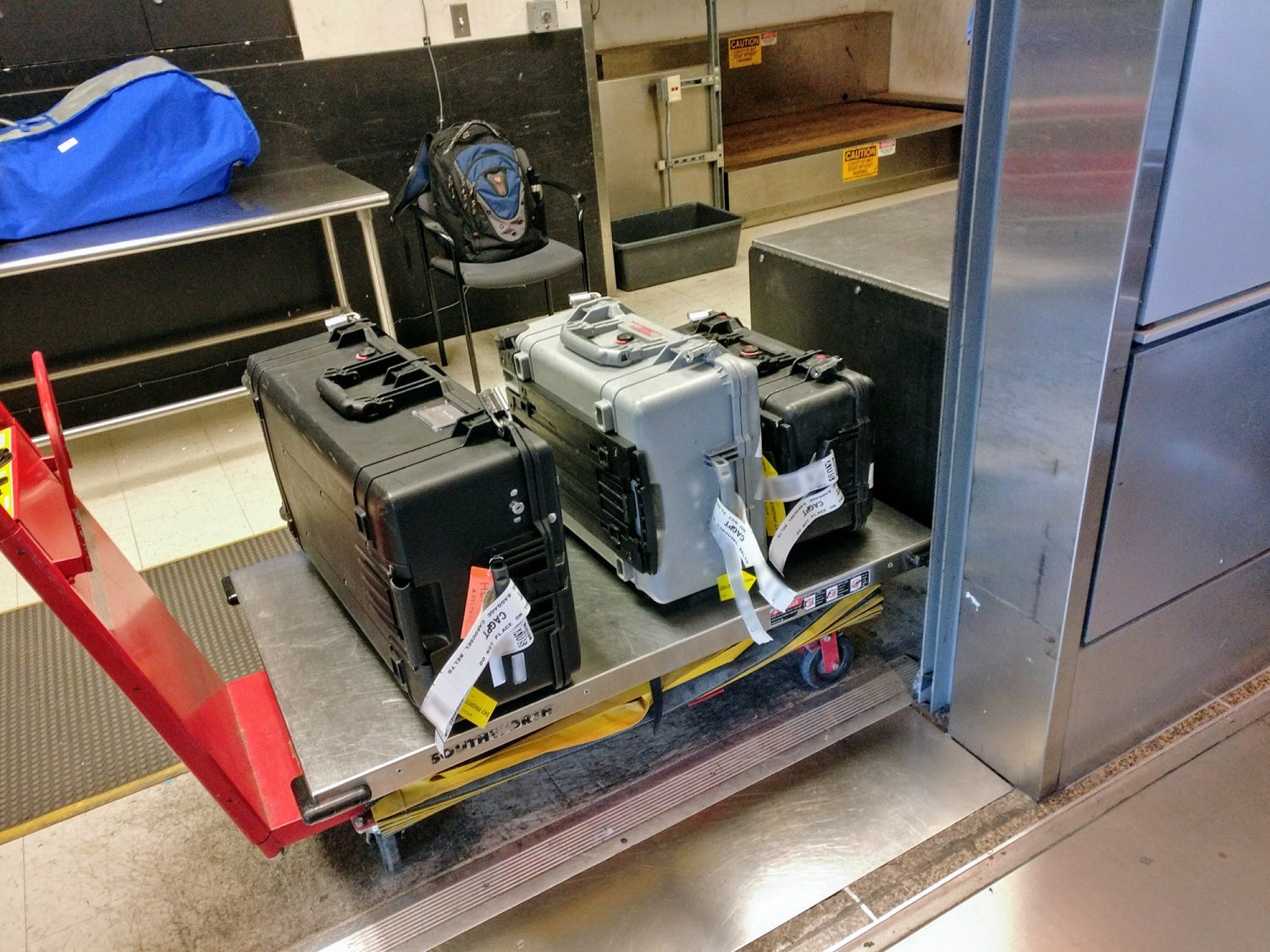
The author and his wife have three pieces of checked luggage, all of which contain firearms. Despite some cases being large and others being small, they have all been brought to the “oversize” TSA screening area where they will all be cleared directly in view of the passengers so there can be no doubt that everything proceeds smoothly.
2. Help Passengers Verify Luggage Progress
Many of you frequent fliers may have the smartphone app for your preferred carrier installed. In addition to doing things like changing seats, checking on upgrade status, or getting notices about possible delays, perhaps you also make use of these apps’ ability to inform you about the status of your luggage as it accompanies you on your journey. My wife and I both appreciate seeing notifications buzz on our phones when a bag is loaded or unloaded from the belly of an aircraft. Delta, in particular, has been rolling out RFID luggage tracking to great effect.
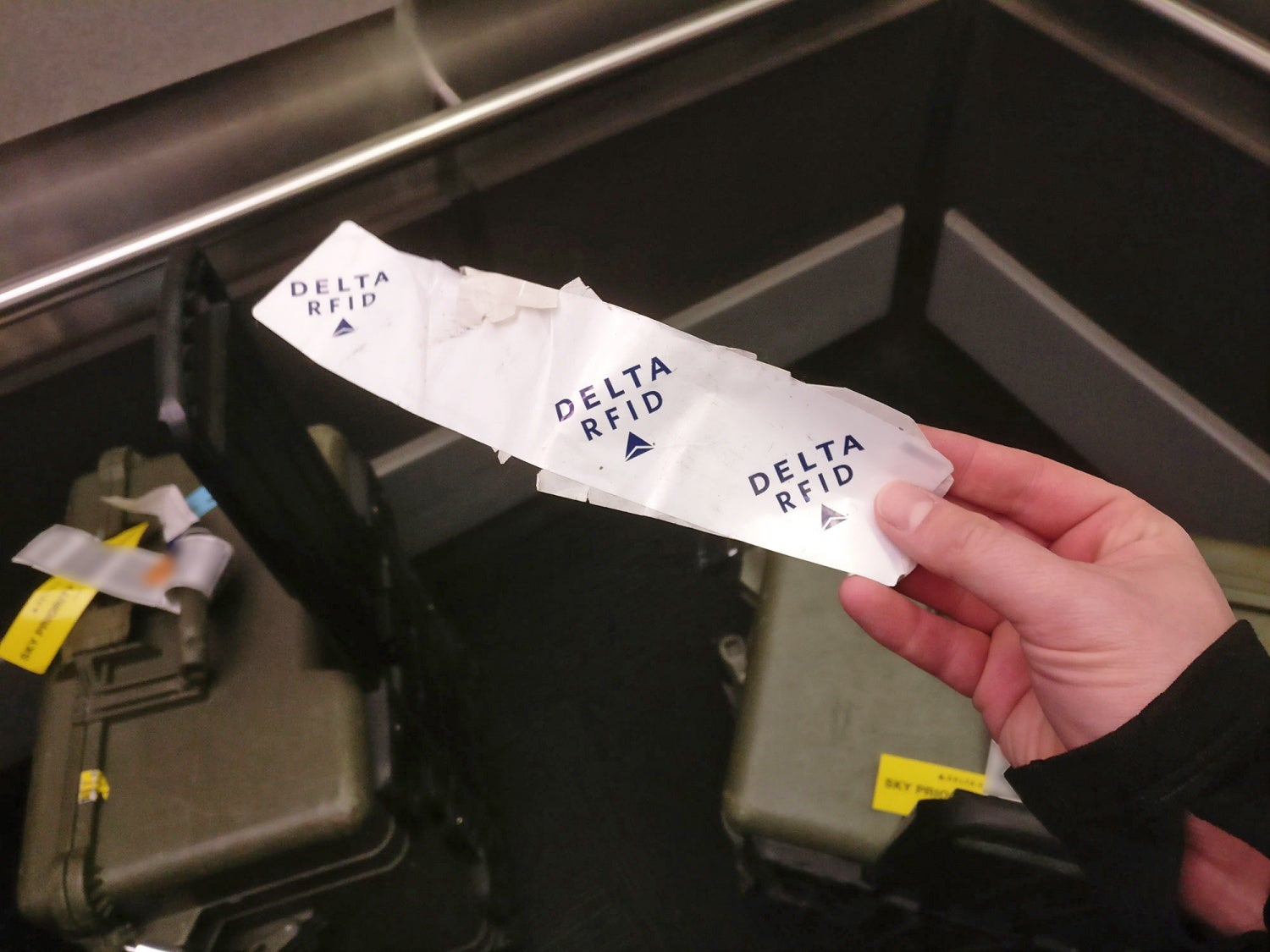
The RFID-enabled luggage tracking system used by Delta has afforded this author additional insight into when luggage has cleared TSA screening.
Thanks to the 900 MHz tags now embedded in all Delta luggage stickers, passengers can receive regular updates informing them whenever their bags have been loaded onto a plane, taken off of a plane, or sent to a claim area. However, it interested me greatly to learn that this is not the only data which Delta receives concerning baggage movement. Staff members at BWI informed me that there are dozens of checkpoints through which bags pass while registering on the RFID trackers.
Baltimore is notorious for cutting locks off of gun cases. It has happened there at least three times now to one of the guys on my team. Knowing this, a number of airline staff were working with me in an attempt to determine if the TSA had finished processing my gun case or not and they were having no luck reaching the screening room. One of the Delta agents then hit upon a remarkable idea: they started typing into their terminal and remarked, “Even if we can’t get the TSA to answer their damn phone, maybe we can at least see if the bag has popped in our system yet.” I was astonished at how simple this solution was. By verifying that the RFID tag on my Pelican case had registered as “being transported to aircraft” we were able to all rest easy, knowing that the TSA had cleared it. This level of granular tracking detail is not offered in the Delta smartphone app, but there is absolutely no reason it couldn’t be added.
Imagine how helpful that would be to passengers who are flying with firearms… no more “stand around and wait fifteen minutes and you should be good” instructions. No more blank stares or shoulder shrugs or phone calls to nowhere tying up the check-in staff’s valuable time. If passengers could be directly alerted when the TSA has cleared a gun case, this would go a long way toward preventing mishaps.
Have You Got a Flying with Firearms Story to Tell?
For years now, I have been maintaining a website full of accounts from travelers who have flown with firearms. If you have an experience of packing in the friendly skies that you’d like to share with me, I’d love to hear from you. If you send me an email with details of how you were treated on your journey, I’ll add it to the published accounts page.
Starting in March of 2017, my fellow travelers and I started to have very interesting stories, particularly when we went to the luggage claim area to collect firearms cases at our destination. One carrier has started doing something particularly bizarre and it boggles everyone’s mind just how inane their new policy is.
The story of the policy, along with loads of data and facts about how inconsistently it’s being implemented, is the focus of the third and final article in this series.
 Your Privacy Choices
Your Privacy Choices
